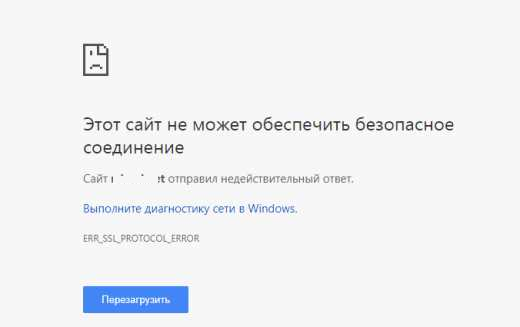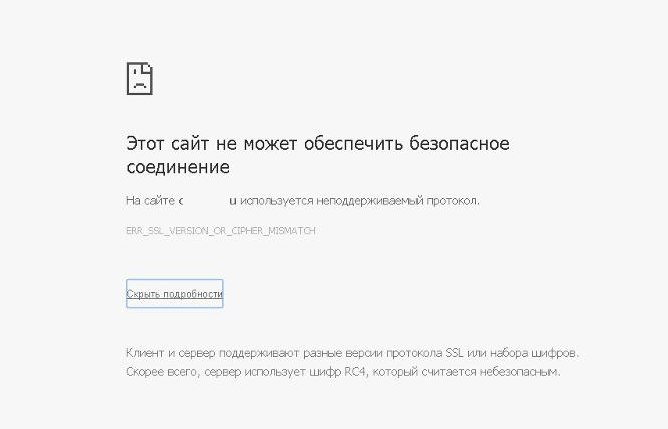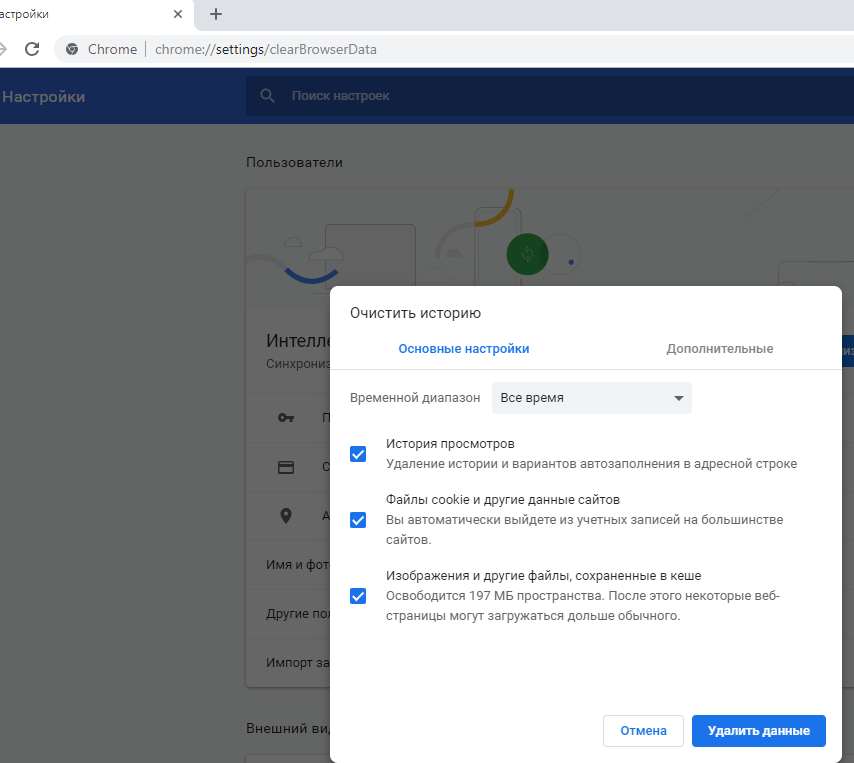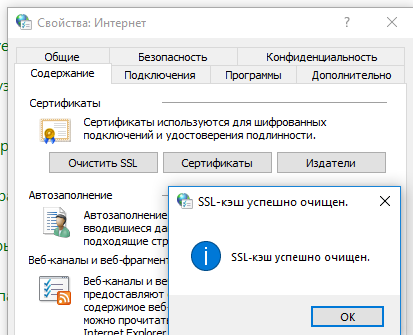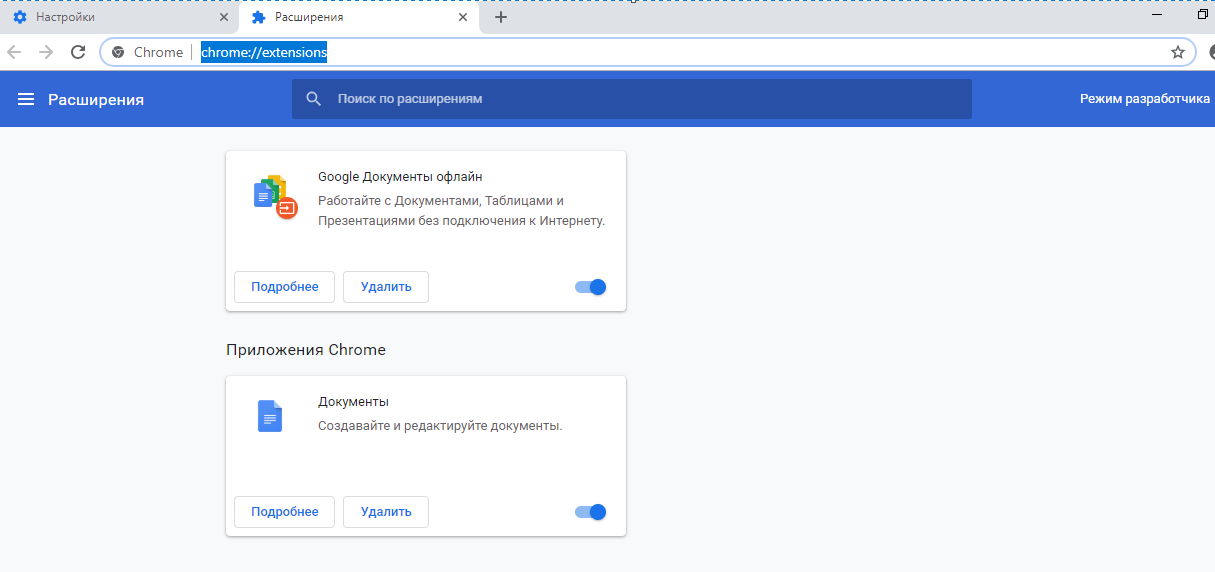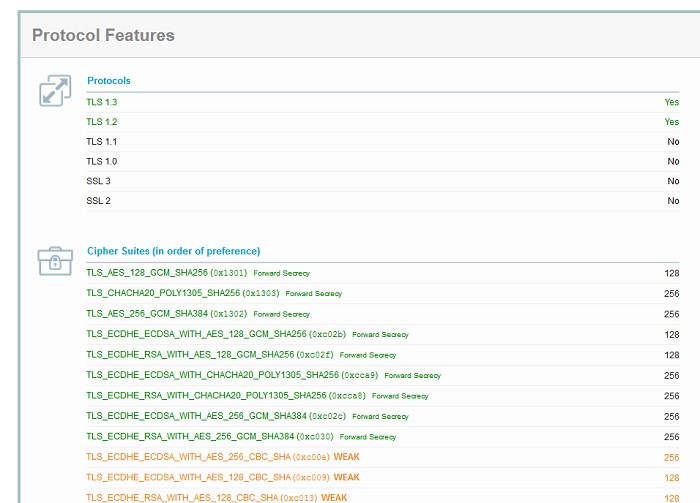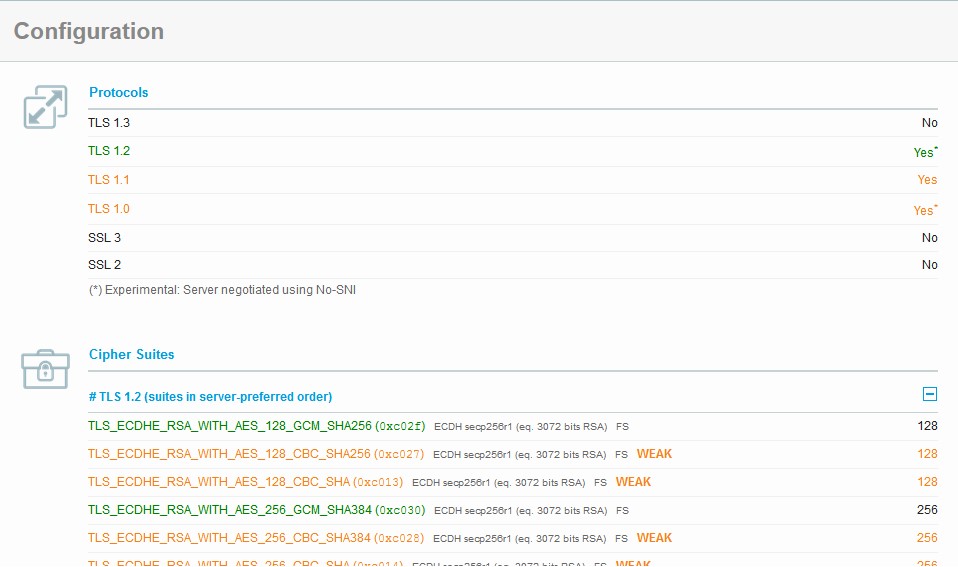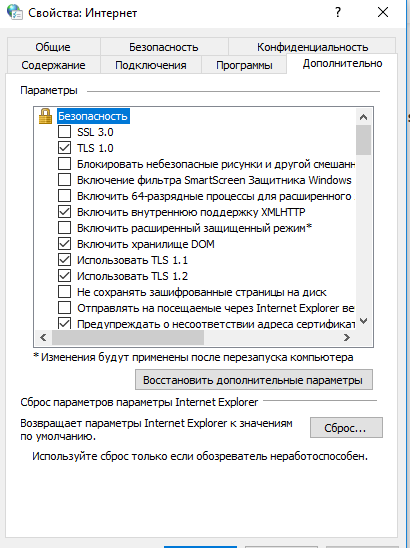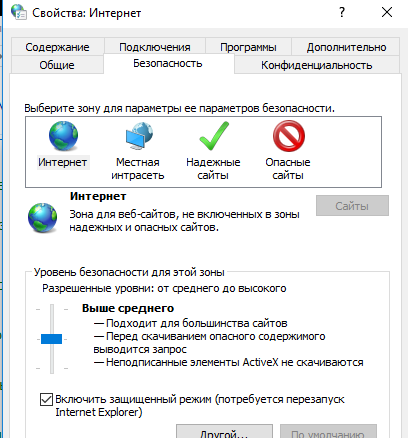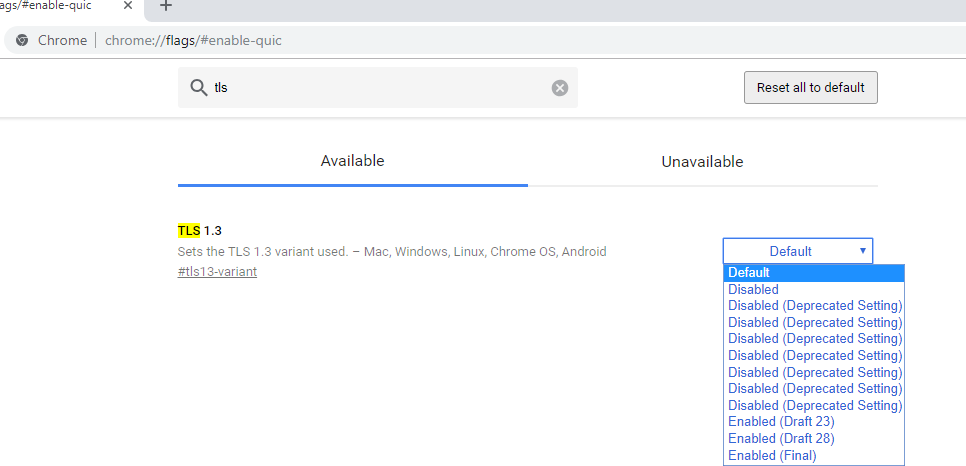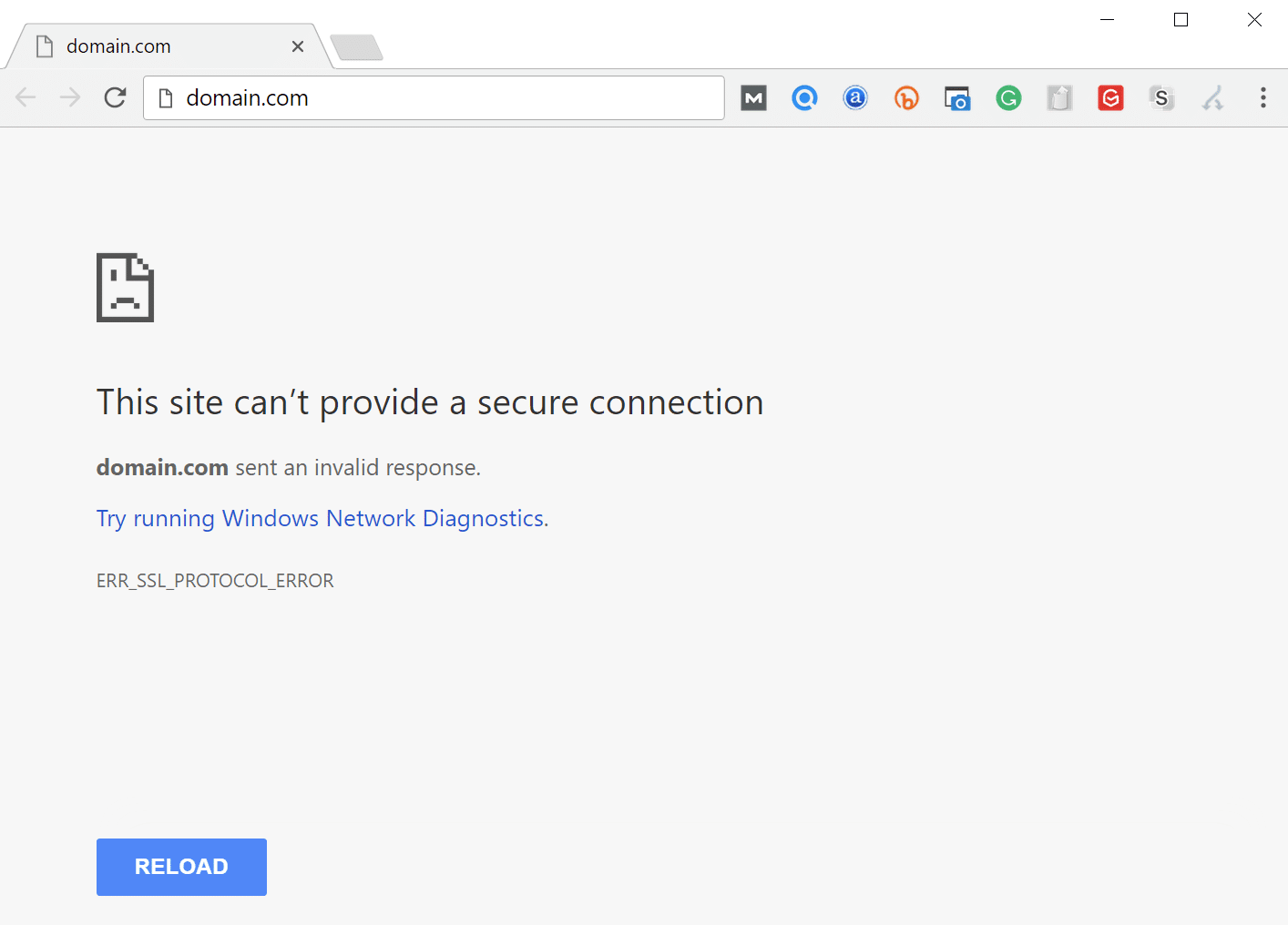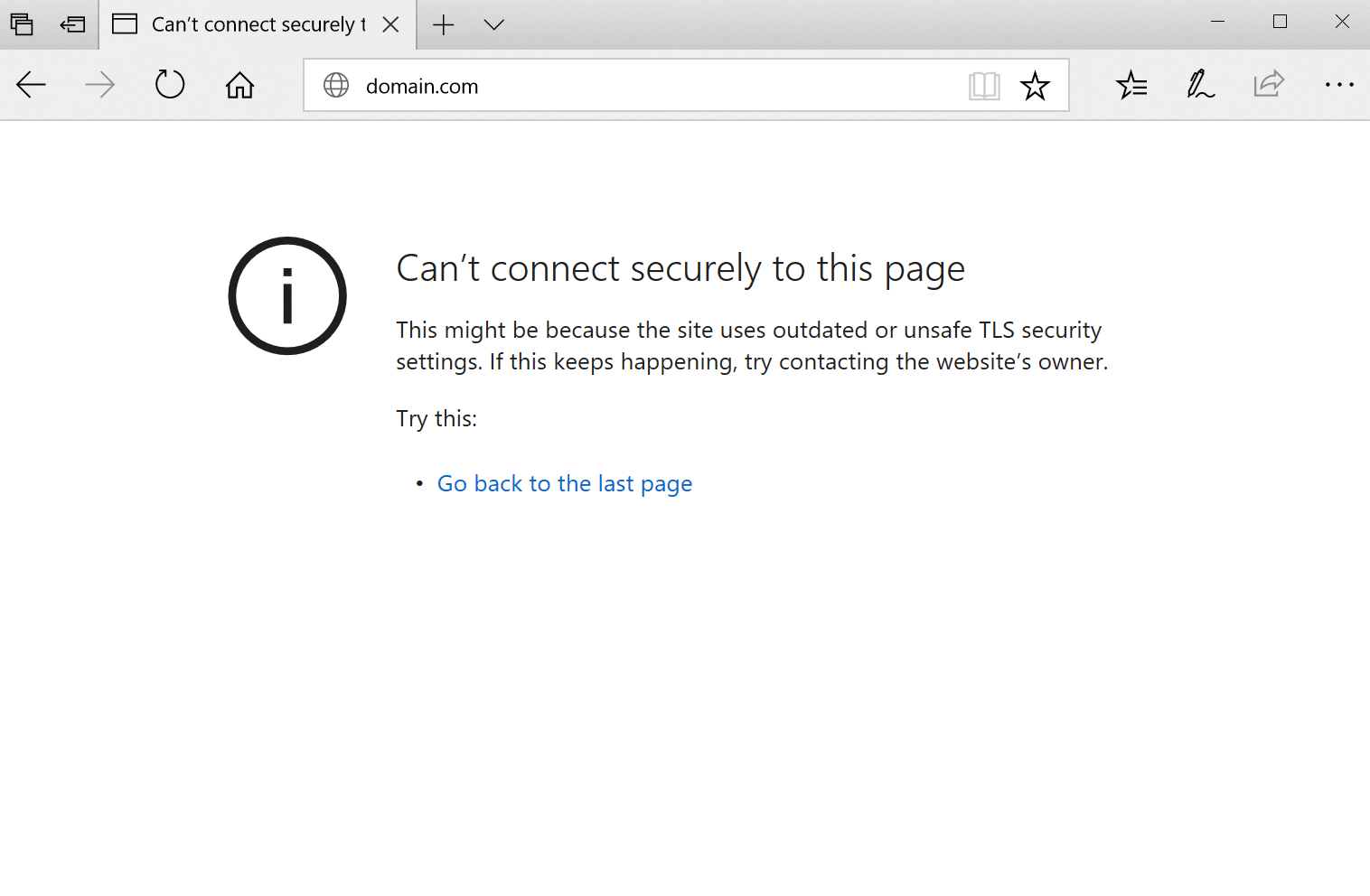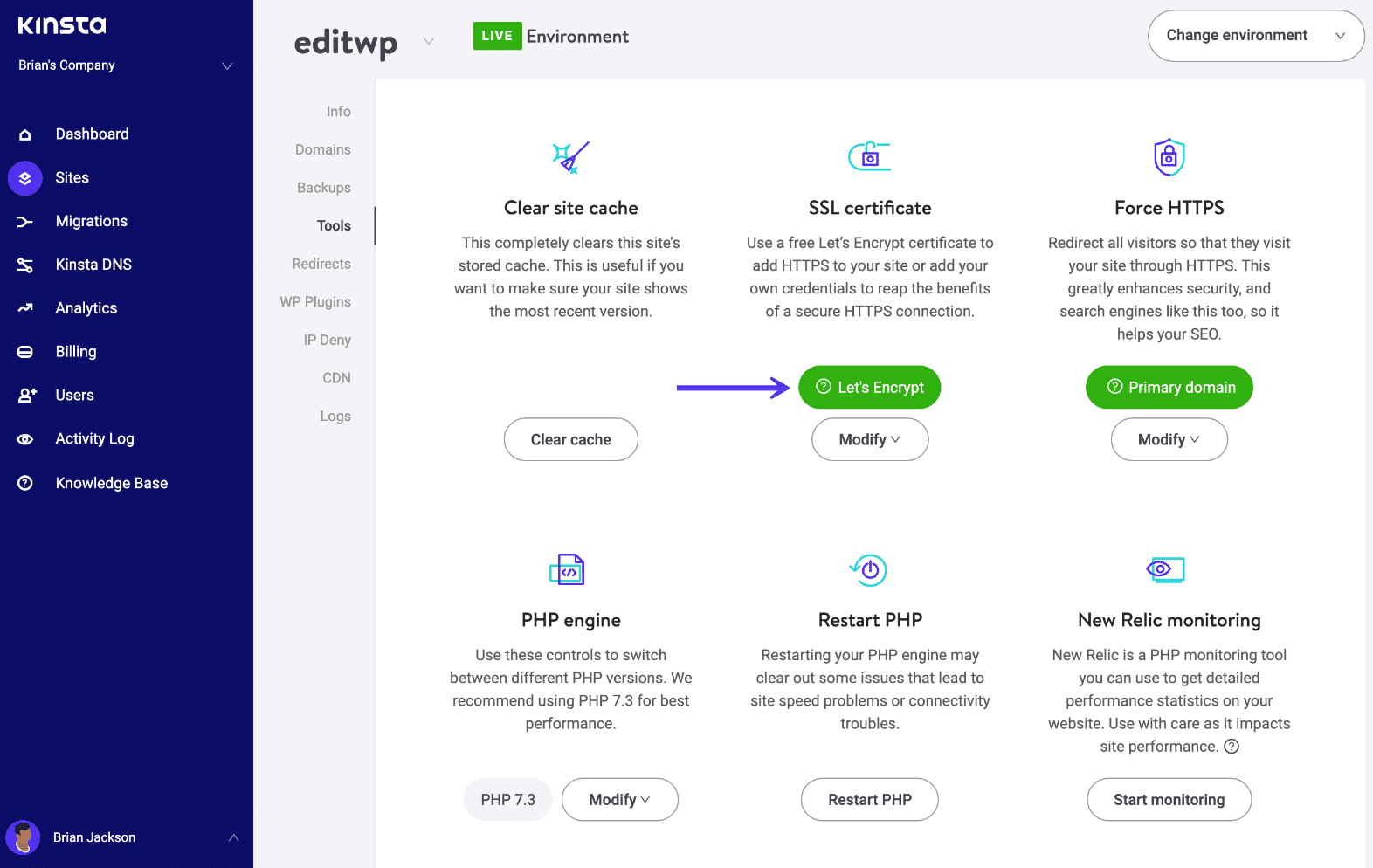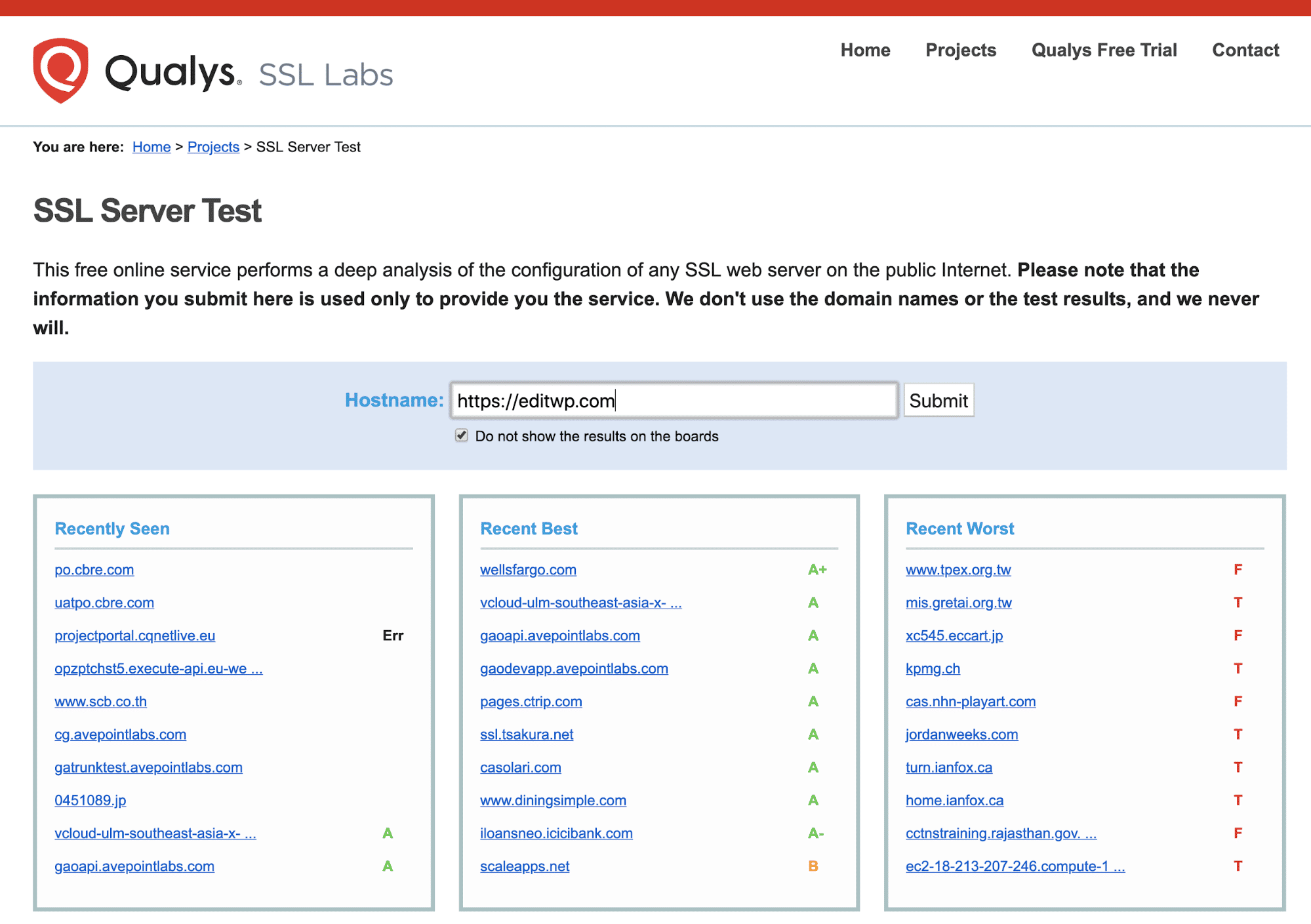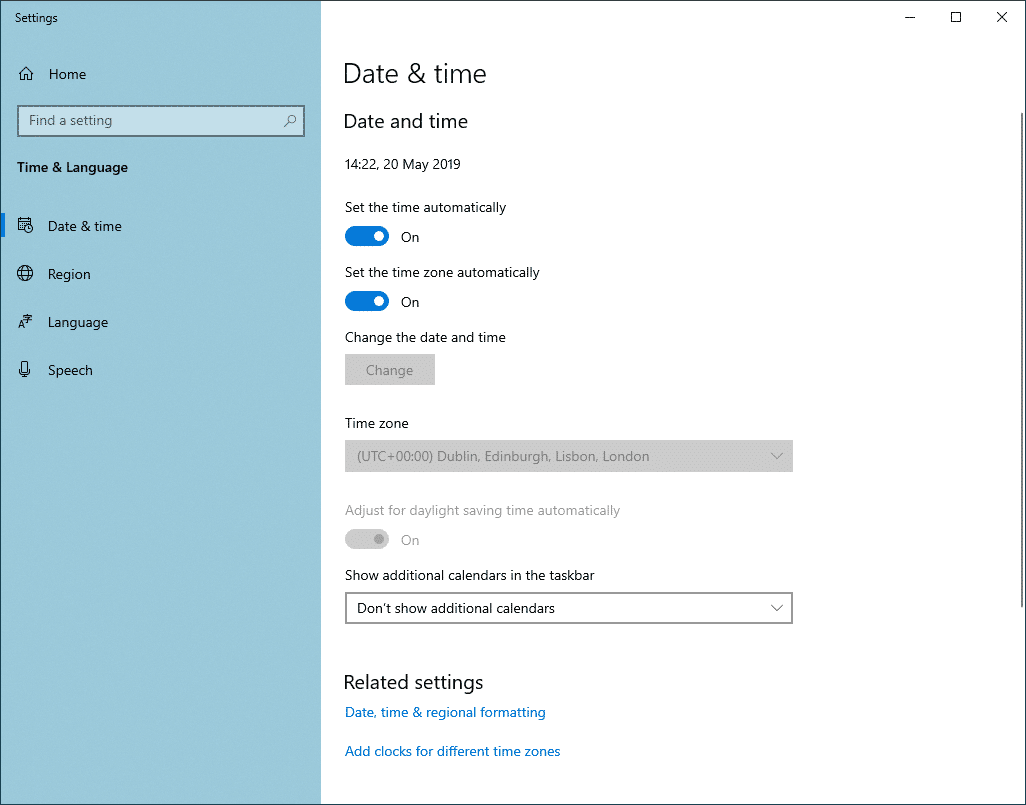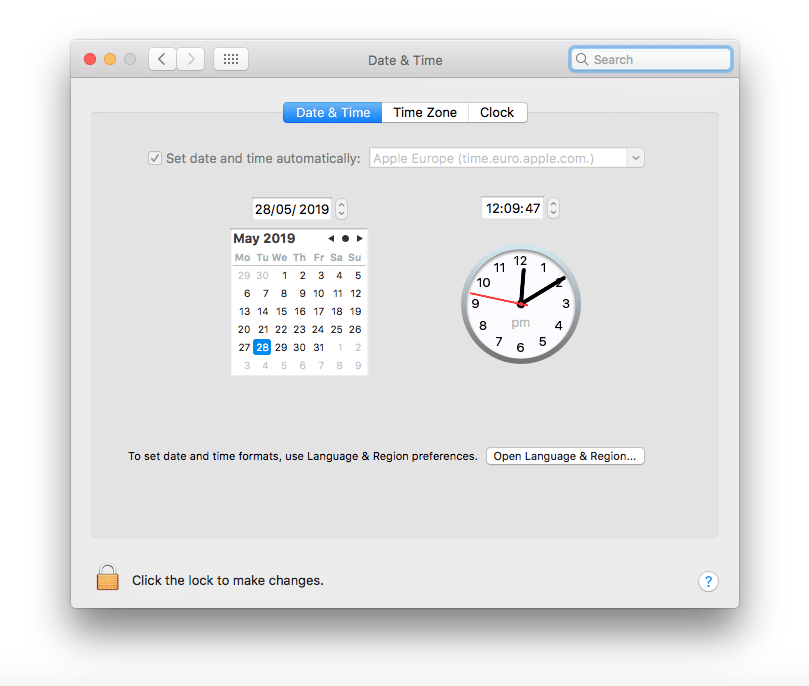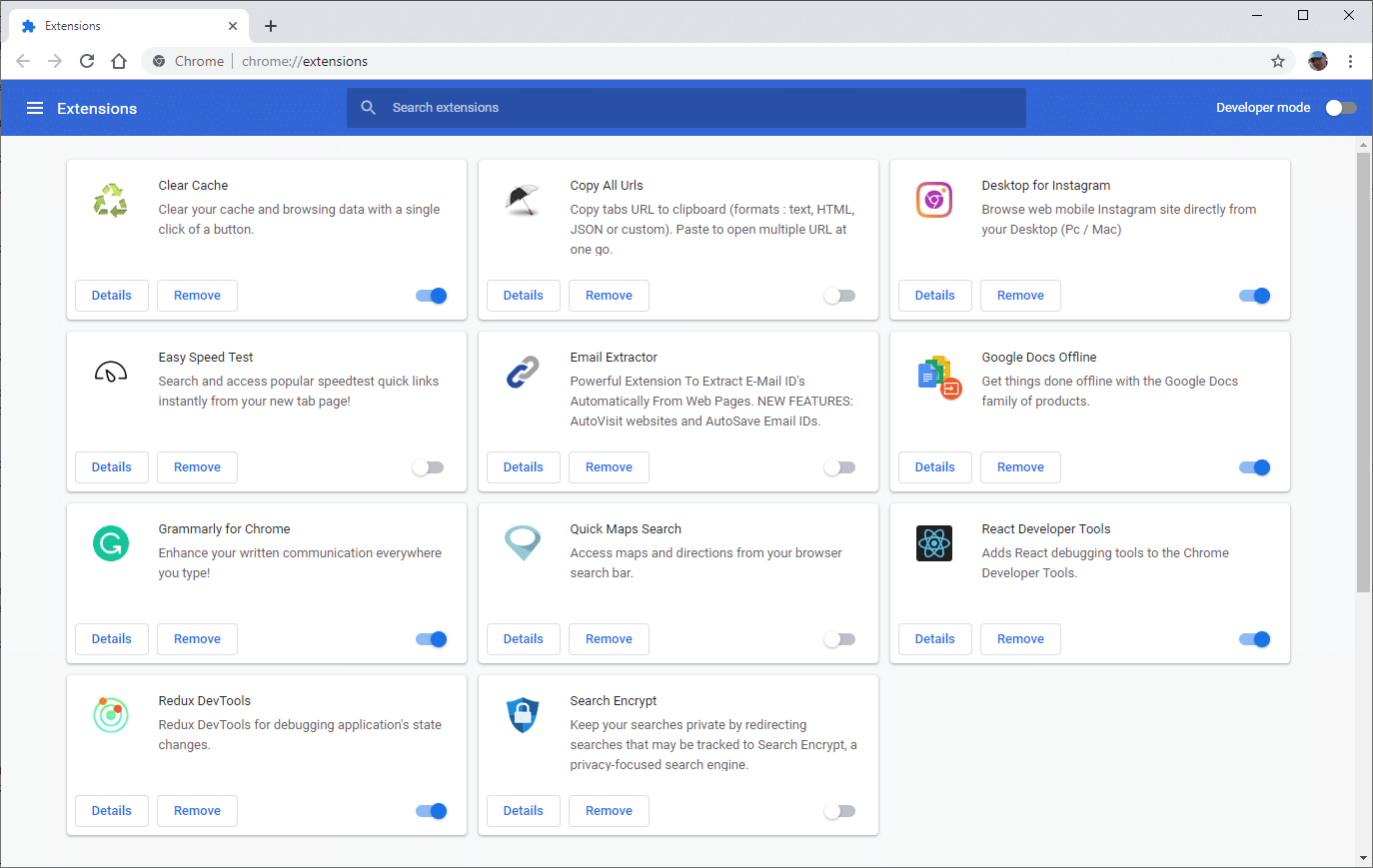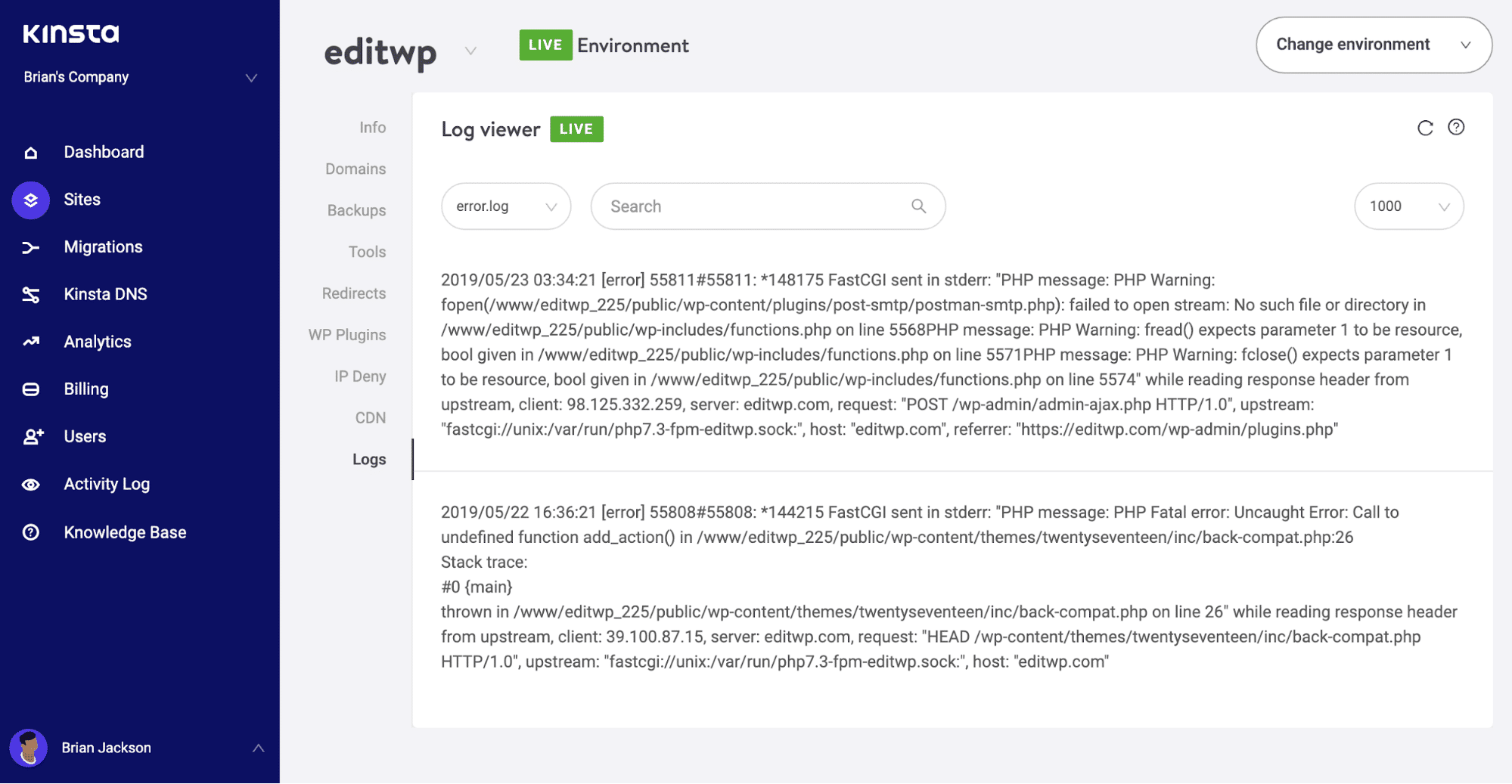Краткое руководство о том, как исправить ошибку в Chrome «Этот сайт не может обеспечить безопасное соединение» или «ERR_SSL_PROTOCOL_ERROR».
Если Google Chrome – ваш основной доступ в мир интернета, вы должны были хотя бы раз столкнуться с ошибкой «Этот сайт не может обеспечить безопасное соединение» или уведомлением об ошибке ERR_SSL_PROTOCOL_ERROR. В целом это описывает ряд ошибок, что вызывает разочарование, так как в большинстве случаев нет легко распознаваемой причины. Ошибки SSL могут появляться как на самых популярных сайтах, так и на самых менее посещаемых.
Как мы только, что обсуждали, что касается причины, по которой Google иногда говорит: «Этот сайт не может обеспечить безопасное соединение», то практически невозможно связать ее с одной причиной. Это может быть что угодно, от такой тривиальной проблемы, как неправильная дата в системе, до гораздо более сложных проблем с сервером.
Шаги по устранению неполадок, чтобы исправить ERR_SSL_PROTOCOL_ERROR в Google Chrome. Если какой-то не помог, попробуйте следующий совет.
ERR_SSL_PROTOCOL_ERROR дата и время
Касаемо сбитой даты и времени, по последним данным ошибка будет именно ERR_CERT_DATE_INVALID
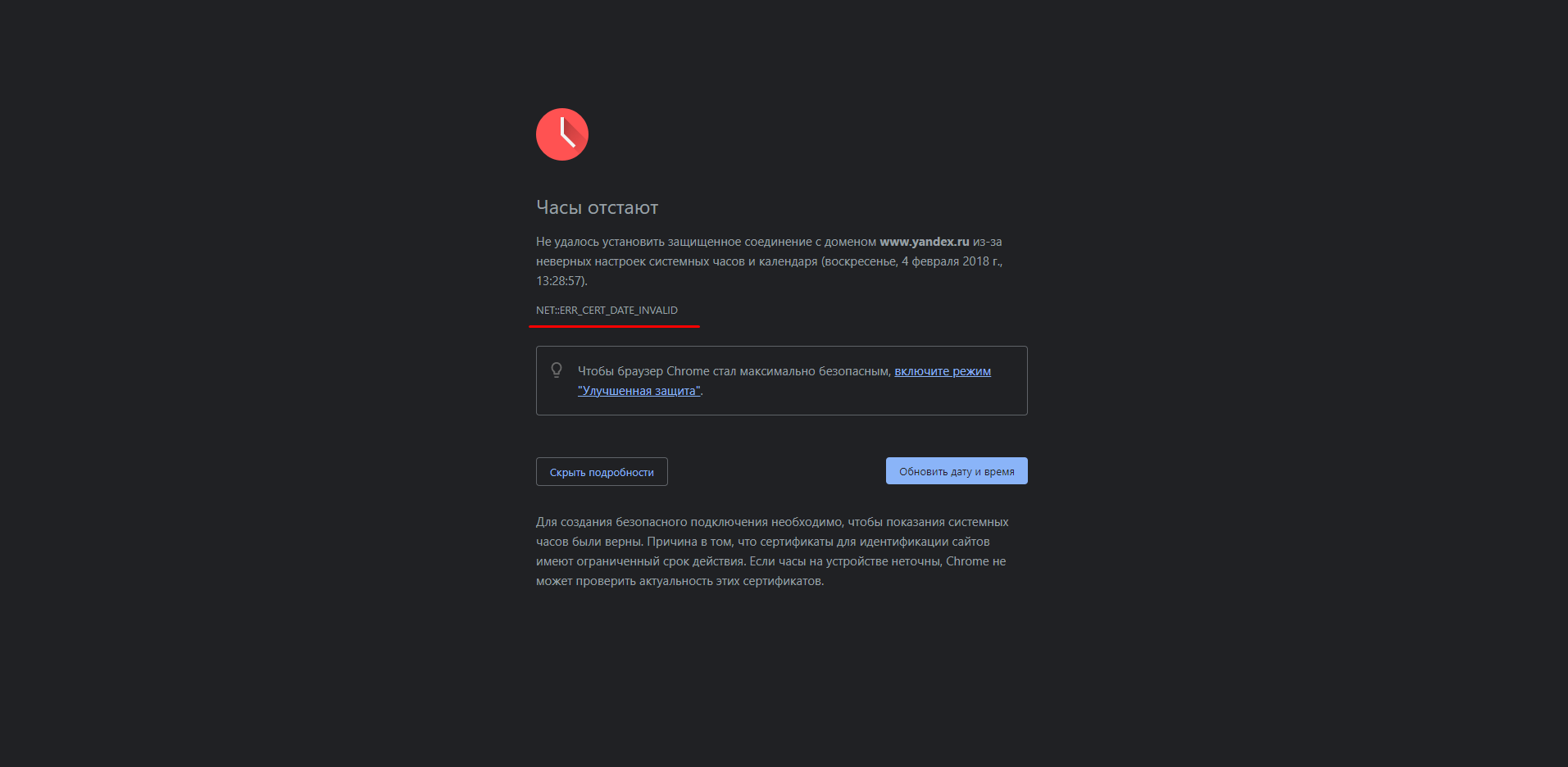
В этом случае неправильные настройки даты и времени могут вызывать у вас проблемы. Итак, убедитесь, что ваша система не отстает и не забегает вперед. Почему это проблема? Срок действия ssl сертификата является чрезвычайно важным фактором в процессе аутентификации, а это означает, что нужно держать очень конкретные вкладки, указывающие время подписи сертификата и срок его действия. Если есть проблема с временем и датой вашей системы, это может вызвать всевозможные проблемы во время аутентификации. Эти браузеры спроектированы так, чтобы проявлять осторожность, поэтому такая простая вещь, как неправильное время, может вызвать ошибку SSL-соединения.
ERR_SSL_PROTOCOL_ERROR очистка данных браузера Chrome
От одного очевидного решения к другому.
Если у вас правильная дата и время на устройстве, пора очистить кеш и файлы Cookie в Google Chrome. Для этого нажмите Ctrl + Shift + Delete и удалите данные из истории браузера. В целом мы рекомендуем почаще чистить эти данные.
ERR_SSL_PROTOCOL_ERROR очистка состояния SSL
Если ничего из вышеперечисленного не работает, следующее, что вам следует попробовать, — это очистить состояние SSL. Для этого выполните следующие действия:
1. Сначала перейдите в раздел «Настройка и управление Google Chrome» — три точки, которые вы видите чуть ниже кнопки закрыть.
2. Теперь нажмите «Настройки».
3. Прокрутите страницу вниз и откройте Дополнительные настройки.
4. Перейдите к разделу «Открыть настройки прокси», прокрутив вниз или выполнив поиск в строке поиска.
5. Откроется окно с названием «Свойства Интернета».
6. Перейдите в окно содержимого и нажмите кнопку «Очистить состояние SSL».
Исправление этой ошибки по-средством отключения протокола QUIC
QUIC (Quick UDP Internet Connections) обеспечивает подключение к серверам Google, эквивалент TLS/SSL. По умолчанию в Chrome включен протокол QUIC.
Чтобы отключить его, скопируйте chrome: // flags / # enable-quic (без пробелов) и вставьте его в адресную строку, нажмите Enter. В верхней части экрана установлен по умолчанию протокол QUIC. Отключите его и перезапустите Chrome.
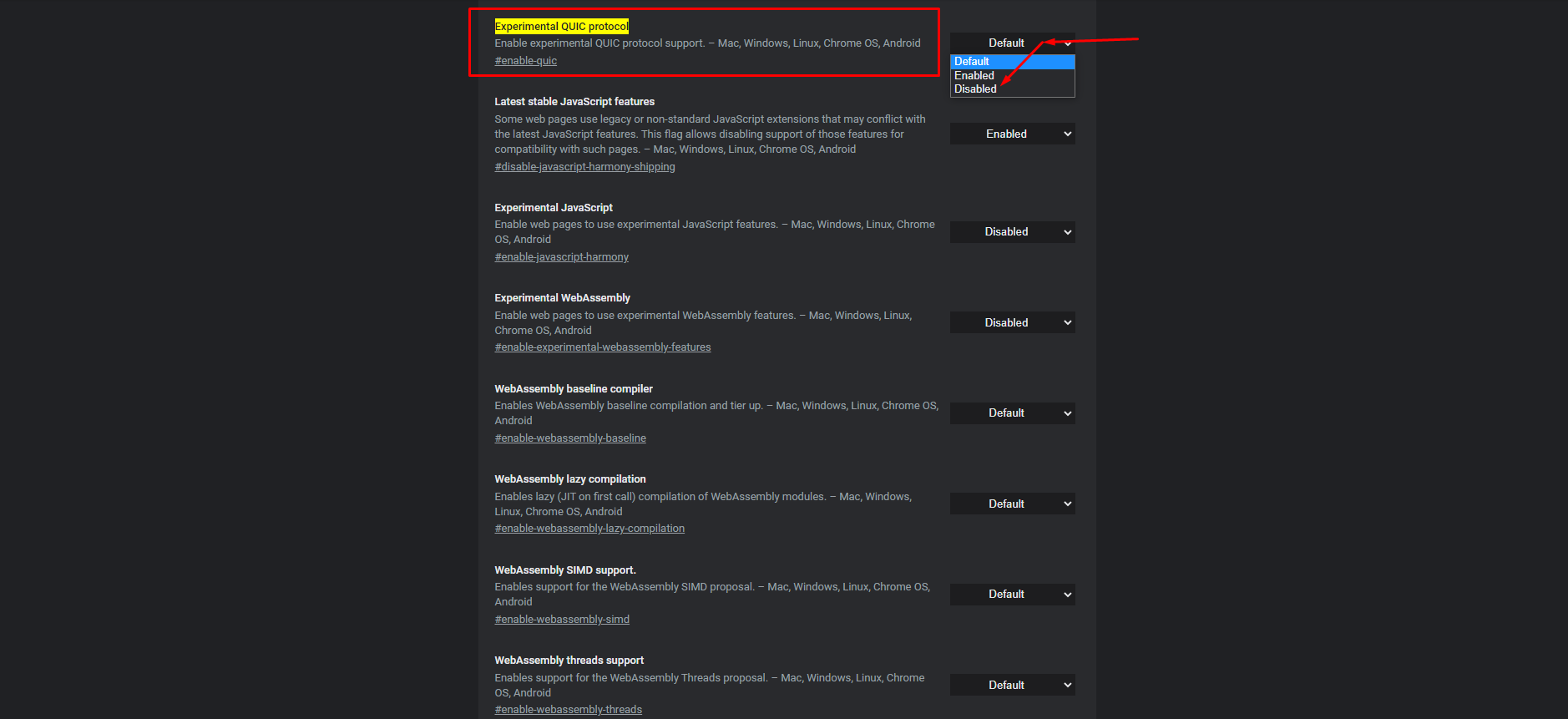
Это не обязательно совет, но было доказано, что это работает в некоторых малоизвестных случаях, поэтому мы включаем его в список.
Проверьте настройки антивируса
Предупреждение: этот шаг не совсем безопасен, поскольку он разрешает использовать старые и небезопасные протоколы SSL/TLS, которые все еще используются на некоторых веб-сайтах.
Возможно, вы этого не знаете, но ваше антивирусное программное обеспечение следит за веб-страницами, которые вы посещаете, и защищает вас от любых угроз, которые они могут представлять или содержать. Это делается путем проверки протокола SSL/TLS, который использует веб-сайт. Если протокол окажется небезопасным и устаревшим, он не позволит вам посетить сайт.
Не существует единого способа изменить настройки для всего антивирусного программного обеспечения, поскольку пользовательский интерфейс и настройки отличаются от одного программного обеспечения к другому. Вам нужно будет найти и посмотреть, сканирует ли он протоколы SSL. Если это так, отключите его и посмотрите, что произойдет. Если проблема не исчезнет, вернитесь к исходным настройкам.
Примечание
Обычно причина того, что антивирусная программа вызывает тревогу о соединении SSL/TLS, заключается в том, что сервер пытается установить соединение, используя устаревшую или уязвимую версию SSL или TLS, такую как SSL 3.0 или TLS 1.0.
Включите все версии SSL/TLS — как последний шаг
Предупреждение: этот шаг не совсем безопасен, поскольку он позволяет использовать старые и небезопасные протоколы SSL/TLS, которые все еще используются на некоторых веб-сайтах.
Когда вы посещаете веб-сайт с SSL соединением, он использует протоколы SSL/TLS для связи с сервером. Иногда версия веб-сайта SSL/TLS может быть несовместима с вашей версией браузера Chrome, поскольку Chrome по умолчанию не разрешает запуск устаревших протоколов SSL/TLS. Следовательно, вам нужно изменить эти настройки протокола SSL/TLS:
1. Нажмите на три точки, которые вы видите в правом верхнем углу Chrome, и нажмите «Настройки».
2. Теперь прокрутите вниз и перейдите к дополнительным настройкам.
3. Найдите настройки прокси и откройте его.
4. Нажмите на Advanced (расширенные настройки)
5. Прокрутите вниз, пока не появится раздел Безопасность. Теперь убедитесь, что вы подключили все версии SSL и TLS.
6. Щелкните Применить.
7. Перезапустите Chrome.
Примечание
Считайте этот совет теоретическим. Все основные браузеры объявили о планах отключить поддержку всех предыдущих версий TLS, сохранить TLS 1.2 и недавно опубликованный TLS 1.3. Это делается из соображений безопасности. Не включайте поддержку устаревших версий TLS и SSL с известными уязвимостями. Никакая законная организация не попросит вас нарушить настройки безопасности вашего браузера для взаимодействия с их веб-сайтом.
Мы надеемся, что это руководство помогло вам исправить сообщения ERR_SSL_PROTOCOL_ERROR в браузере Chrome. А если нет, поделитесь комментариями к этой статье и мы постараемся помочь вам с этим.
У меня почему-то перестали открываться некоторые HTTPS сайты (не все!). При попытке открыть такой сайт в браузере появляется окно с ошибкой «Этот сайт не может обеспечить безопасное соединение». Сайты не отображаются как в Google Chrome, так и в Opera, Яндекс Браузере и Microsoft Edge. Без HTTPS некоторые сайты открываются, но не все, только те, у которых страницы доступны и по протоколу HTTPS и по протоколу HTTP. В Google Chrome ошибка при открытии HTTPS сайт выглядит так:
Этот сайт не может обеспечить безопасное соединение. Сайт sitename.ru отправил недействительный ответ. ERR_SSL_PROTOCOL_ERROR.
И так:
Этот сайт не может обеспечить безопасное соединение. На сайте sitename.ru используется неподдерживаемый протокол. ERR_SSL_VERSION_OR_CIPHER_MISMATCH.
Клиент и сервер поддерживают разные версии протокола SSL и набора шифров. Скорее всего, сервер использует шифр RC4, который считается небезопасный.» [/alert]
Или в Mozilla Firefox :
Secure Connection Failed
В Opera и Яндекс Браузере ошибки выглядит примерно также.
Как мне открыть такие сайты?
Ответ
Как вы уже вероятно поняли, проблема связана с проблемами при SSL взаимодействии между вашим компьютеров и HTTPS сайтом. Причины такой ошибки могут быть довольно разные. В этой статье я попробовал собрать все методы исправления ошибки «Этот сайт не может обеспечить безопасное соединение» (This site can’t provide a secure connection, ERR_SSL_PROTOCOL_ERROR) в различных браузерах.
Содержание:
- Очистите в брайзере кэш и куки, сбросьте SSL кэш
- Отключите сторонние расширения в браузере
- Проверьте настройки антивируса и файрвола
- Проверьте настройки даты и времени
- Обновите корневые сертификаты Windows
- Отключите поддержку протокола QUIC
- Проверьте версии протоколов TLS, поддерживаемых вашим браузером и сайтом
- Включите поддержку старых версий протоколов TLS и SSL
Сразу хочется отметить, что несмотря на то, что браузеры Google Chrome, Opera, Яндекс Браузер и Edge выпускаются разными компаниями, на самом деле все эти браузеры основаны на одном и том же движке — WebKit (Chromium) и проблема с ошибками при открытии HTTPS сайтов в них решается одинаково.
В первую очередь нужно убедиться, что проблема не на стороне самого HTTPS сайта. Попробуйте открыть его с других устройств (телефон, планшет, домашний/рабочий компьютер и т.д.). Также проверьте, открывается ли в других браузерах, например, IE/Edge или Mozilla Firefox. В Firefox похожая ошибка обсуждалась в статье Ошибка при установлении защищённого соединения в Mozilla Firefox.
Очистите в брайзере кэш и куки, сбросьте SSL кэш
Кэш и куки браузера могут быть частой причиной возникновения ошибок с SSL сертификатами. Рекомендуем сначала очистить в браузере кэш и куки. В Chrome нужно нажать сочетание клавиш Ctrl + Shift + Delete, выберите промежуток времени (Все время) и нажмите кнопку очистки данных (Удалить данные / Clear Data).
Чтобы очистить SSL кэш в Windows:
- Перейдите в раздел Панель управления -> Свойства браузера;
- Щелкните по вкладке Содержание;
- Нажмите на кнопку Очистить SSL (Clear SSL State);
- Должно появится сообщение “SSL-кэш успешно очищен”;
- Осталось перезапустить браузер и проверить, осталась ли ошибка ERR_SSL_PROTOCOL_ERROR.
Отключите сторонние расширения в браузере
Рекомендуем отключить (удалить) сторонние расширения браузера, особенно всякие анонимайзеры, прокси, VPN, расширения антивируса и другие подобные Addon-ы, которые могут вмешиваться в прохождение трафика до целевого сайта. Посмотреть список включенных расширения в Chrome можно, перейдя в Настройки -> Дополнительные инструменты -> Расширения, или перейдя на страницу
chrome://extensions/
. Отключите все подозрительные расширения.
Проверьте настройки антивируса и файрвола
Если на вашем компьютере установлены антивирусная программа или межсетевой экран (часто он встроен в антивирус), возможно доступ к сайту блокируется именно ими. Чтобы понять, ограничивают ли доступ к сайту антивирусы или файрволы, попробуйте на время приостановить их работу.
Во многих современных антивирусах по-умолчанию присутствует модуль проверки SST/TLS сертификатов сайтов. Если антивирус обнаружит, что сайт использует недостаточно защищенный (или самоподписанный) сертификат или устаревшую версию протокола SSL (тот же SSL 3.0 или TLS 1.0), доступ к пользователя к такому сайту может быть ограничен. Попробуйте отключить сканирование HTTP/HTTPS трафика и SSL сертификатов. В различных антивирусах эта опция может называть по-разному. Например:
Проверьте настройки даты и времени
Неправильная дата и время (и часового пояса) на компьютере также может быть причиной ошибки при установке защищенного соединения с HTTPS сайтами. Ведь при выполнении аутентификации система проверяет срок создания и дату истечения сертификата сайта и вышестоящего центра сертификации.
Проверьте что у вас установлено правильно время и часовой пояс. Если время постоянно сбивается – смотри статью “Сбивается время на компьютере при выключении: что делать?”.
Обновите корневые сертификаты Windows
Если ваш компьютер находится в изолированном сегменте, давно не обновлялся или на нем совсем отключена служба автоматического обновления, на вашем компьютере могут отсутствовать новые корневые доверенные сертификаты (TrustedRootCA). Рекомендуем выполнить обновление системы: установить последние обновления безопасности и обновления часовых поясов.
Вы можете вручную обновить корневые сертификаты по статье: Как вручную обновить корневые сертификаты в Windows (так же рекомендуем проверить хранилище сертификатов на предмет недоверенных сертификатов, это позволит предотвратить перехват вашего HTTPs трафика и ряд других проблем).
Отключите поддержку протокола QUIC
Проверьте, не включена ли в Chrome поддержка протокола QUIC (Quick UDP Internet Connections). Протокол QUIC позволяет гораздо быстрее открыть соединение и согласовать все параметры TLS (HTTPs) при подключении к сайту. Однако в некоторых случая он может вызывать проблемы с SSL подключениями. Попробуйте отключить QUIC:
- Перейдите на страницу: chrome://flags/#enable-quic;
- Найдите опцию Experimental QUIC protocol;
- Измените значение опции Default на Disabled;
- Перезапустите Chrome.
Проверьте версии протоколов TLS, поддерживаемых вашим браузером и сайтом
Проверьте, какие версии протоколов TLS/SSL и методы шифрования (Cipher Suite ) поддерживаются вашим браузером. Для этого просто откройте веб страницу https://clienttest.ssllabs.com:8443/ssltest/viewMyClient.html
Онлайн сервис SSL Labs вернет список протоколов и методов шифрования, которые поддерживает ваш блаузер. Например, в моем примере Chrome поддерживает TLS 1.3 и TLS 1.2. Все остальные протоколы (TLS 1.1, TLS 1.0, SSL3 и SSL 2) отключены.
Чуть ниже указан список поддерживаемых методов шифрования.
Cipher Suites (in order of preference)
- TLS_AES_128_GCM_SHA256
- TLS_CHACHA20_POLY1305_SHA256
- TLS_AES_256_GCM_SHA384
- TLS_ECDHE_ECDSA_WITH_AES_128_GCM_SHA256
- TLS_ECDHE_RSA_WITH_AES_128_GCM_SHA256
- TLS_ECDHE_ECDSA_WITH_CHACHA20_POLY1305_SHA256
- TLS_ECDHE_RSA_WITH_CHACHA20_POLY1305_SHA256
- TLS_ECDHE_ECDSA_WITH_AES_256_GCM_SHA384
- TLS_ECDHE_RSA_WITH_AES_256_GCM_SHA384
- TLS_ECDHE_ECDSA_WITH_AES_256_CBC_SHA
- TLS_ECDHE_ECDSA_WITH_AES_128_CBC_SHA
- TLS_ECDHE_RSA_WITH_AES_128_CBC_SHA
- TLS_ECDHE_RSA_WITH_AES_256_CBC_SHA
- TLS_RSA_WITH_AES_128_GCM_SHA256
- TLS_RSA_WITH_AES_256_GCM_SHA384
- TLS_RSA_WITH_AES_128_CBC_SHA
- TLS_RSA_WITH_AES_256_CBC_SHA
Полный список методов шифрования, включенных в Windows можно вывести с помощью PowerShell:
Get-TlsCipherSuite | Format-Table -Property CipherSuite, Name
Затем проверьте список протоколов TLS/SSL, которые поддерживает ваш сайт. Для этого воспользуйтесь онлайн сервисом проверки SSL
https://www.ssllabs.com/ssltest/analyze.html?d=domain.ru
(замените
domain.ru
на адрес сайта, который вы хотите проверить).
Проверьте, все ли версии TLS/SSL поддерживаемые сайтом доступны в вашем браузере.
В этом примере видно, что сайт не поддерживает TLS 3.1 и SSL3/2. Аналогично сравните список Cipher Suite.
Если метод шифрования не поддерживается вашим браузером, возможно нужно включить его в Windows.
Если сайт не поддерживает SSL протоколы, которые требует использовать клиент, то при подключении вы увидите ошибку “ Этот сайт не может обеспечить безопасное соединение”.
Включите поддержку старых версий протоколов TLS и SSL
И самый последний пункт. Cкорее всего для решения проблемы вам достаточно будет включить поддержку старых версий протоколов TLS и SSL. В большинстве случае он окажется самым эффективным, но я намеренно перенес его в конец статьи. Объясню почему.
Старые версии протоколов TLS и SSL отключены не по простой прихоти разработчиков, а в связи с наличием большого количества уязвимостей, которые позволяют злоумышленникам перехватить ваши данные в HTTPS трафике и даже видоизменить их. Бездумное включение старых протоколов существенно снижает вашу безопасность в Интернете, поэтому к этому способу нужно прибегать в последнюю очередь, если все другое точно не помогло.
Современные браузеры и ОС уже давно отказались от поддержки устаревших и уязвимых протоколов SSL/TLS (SSL 2.0, SSL 3.0 и TLS 1.1). Стандартном сейчас считаются TLS 1.2 и TLS 1.3
Если на стороне сайта используется более старая версия протокола SSL/TLS, чем поддерживается клиентом/браузером, пользователь видит ошибку установки безопасного подключения ERR_SSL_VERSION_OR_CIPHER_MISMATCH. Такая ошибка появляется, если клиент на этапе TLS Handshake обнаружил, что на сайте используется протокол шифрования или длина ключа, которая не поддерживается вашим браузером. Выше мы показали, как определить набор протоколов и шифров, поддерживаемых сервером.
Чтобы разрешить использовать старые версии протоколов SSL/TLS в Windows (еще раз отмечаю – это небезопасно!):
- Откройте Панель Управления -> Свойства браузера;
- Перейдите на вкладку Дополнительно;
- Включите опции TLS 1.0, TLS 1.1 и TLS 1.2 (если не помогло, включите также SSL 3.0,2.0).
- Перезапустите браузер.
Если все рассмотренные способы не помогли избавиться от ошибки «Этот сайт не может обеспечить безопасное соединение» также попробуйте:
-
- Проверить, что в файле C:WindowsSystem32driversetchosts отсутствуют статические записи. Файл hosts может использоваться в Windows в том числе для блокировки доступа к сайтам. Выведите содержимое файла hosts с помощью PowerShell:
Get-Content $env:SystemRootSystem32Driversetchosts - Попробуйте использовать публичные DNS сервера, например – DNS сервер Google. В настройках сетевого подключения в качестве предпочитаемого DNS сервера укажите IP адрес 8.8.8.8;
- В Панели управления -> свойства браузера, убедитесь, что для зоны Интернет выбрана уровень безопасности Выше среднего или Средний. Если выбрана зона Высокий, некоторые SSL подключения могут блокироваться браузером.
- Возможно проблема связана с сертификатом сайта. Проверьте его с помощью онлайн утилит SSL Checker;
- Если на компьютере используется VPN или задан прокси сервер в Windows, попробуйте отключите их;
- В тестовых целях, если вам нужно быстро просмотреть содержимое сайта, можно отключить ошибки проверки SSL сертификатов в Chrome. Для этого нужно запустить его с параметром —ignore-certificate-errors:
"C:Program Files (x86)GoogleChromeApplicationchrome.exe" --ignore-certificate-errors
(не работайте в таком режиме постоянно и не отправляйте конфиденциальные данные пароли/кредитки в такой сессии); - В Chrome проверьте, включен ли протокол TLS 1.3. В адресной строке перейдите в раздел настроек chrome://flags, С помощью поиска найдите параметр TLS 1.3. Убедитесь, что он включен (Enabled) или находится в состоянии Default. Если отключен – его нужно включить;
- Если у вас используется одна из старых версий ОС (Windows XP или Windows 7), установите вместо Chrome браузер Mozilla Firefox. В отличии от движков на базе Chromium, Mozilla не использует собственные модули реализации протоколов шифрования SSL/TLS, а не встроенные в Windows.
- Проверить, что в файле C:WindowsSystem32driversetchosts отсутствуют статические записи. Файл hosts может использоваться в Windows в том числе для блокировки доступа к сайтам. Выведите содержимое файла hosts с помощью PowerShell:
Для максимальной безопасности сайта у его владельцев должен быть сертификат SSL-стандарта. При активированной поддержке протокола во время перехода на сайт без данного сертификата обязательно появится предупреждение «Этот сайт не может обеспечить безопасное соединение». Рассмотрим, по каким причинам система демонстрирует ошибку «107» с пояснением в виде надписи «NET ERR SSL PROTOCOL ERROR» в браузерах Google Chrome, Яндекс Браузер, Opera и некоторых других.
Содержание статьи
- Предварительные действия
- Установка точной даты и времени
- Отключение протокола QUIC в Google Chrome
- Включение протоколов TLS, SSL
- Очистка кэша браузера и SSL
- Очистка кэша DNS в Windows
- Очистка кэша DNS в браузере
- Действия для Google Chrome, Яндекс, Opera
- Действия для Firefox
- Действия для Internet Explorer 8
- Сброс параметров
- Удаление или очистка файла Hosts
- Отключение расширений
- Снижение уровня безопасности на компьютере
- Корректировка параметров брандмауэра
- Проверка компьютера на вирусы
- Отключение https фильтрации
- Обновление Windows или Android
- Дополнительные рекомендации
- Видео по теме:
- Комментарии пользователей
Предварительные действия
Иногда решение находится на поверхности, поэтому начнем с простых вариантов.
- Проверьте доступ к другим сайтам. Если не получается зайти ни на один сайт, вероятнее всего причиной сбоя является неудовлетворительное качество интернет-подключения. Эту проблему можно решить, обратившись за помощью к службе поддержки провайдера. Подробнее о том, как самостоятельно диагностировать плохое интернет-соединение на примере потери интернет пакетов.
Для информации! Телефон службы поддержки, как правило, имеется на обратной стороне роутера.
- Довольно часто неполадка находится на стороне ресурса. Скорее всего, SSL сертификат не установлен, не правильно настроен или просрочен. Проверить корректность сертификата можно с помощью сервиса sslshopper.com. Введите адрес сайта в специальное окошко и дождитесь результата сканирования. Если владельцем сайта являетесь вы, то после устранения сбоя он автоматически станет доступен для остальных пользователей.
- Перезагрузите устройство. В ходе перезагрузки операционная система произведет целый ряд диагностических процедур, попутно исправляя многие ошибки и неисправности.
- Неполадка может находиться на стороне устаревшего программного обеспечения, а потому обязательно обновите свой браузер. Также его можно полностью удалить и загрузить заново.
- Иногда достаточно просто поменять веб-обозреватель: откройте сайт в другом веб-обозревателе — например, Firefox или Safari.
- В любом браузере есть режим инкогнито: попробуйте зайти на сайт после его активации.
- Если вы используете VPN или прокси, отключите их на время. Возможно, желаемый сайт отказывает в доступе пользователям из конкретного региона.
- Если же вы не используете VPN, то, наоборот, скачайте его и, активировав, проверьте доступ. Так вы сможете обойти блокировку провайдером. Альтернативой скачиванию VPN является любой онлайн прокси-сервис, например, noblock.
- Попробуйте заменить в адресной строке https:// на http://, удалив последнюю букву «s». Однако это не слишком безопасный вариант, поскольку http:// не отвечает современному протоколу безопасности.
- Другим небезопасным методом доступа является временное отключение антивируса. Этот вариант рекомендуется использовать только если вы абсолютно уверены в безопасности интересующего ресурса. Иначе рискуете заразить свой ПК или мобильное устройство опасным вирусом.
Если ничего из вышеперечисленного не помогло, самое время последовательно поискать причину ошибки.
Установка точной даты и времени
Если дата и время установлены неверно, ресурс не будет открываться, поскольку во время аутентификации проверяется время создания и дата истечения сертификата и вышестоящего центра сертификации.
Узнать дату и время своего ПК можно в нижнем правом углу. При этом не имеет значения, какая версия ОС Windows установлена на конкретном компьютере. Действовать требуется следующим образом:
- Кликните правой мышкой по времени внизу экрана и выберите пункт «Настройка даты».
- Включите автоматическую установку даты, или изменить ее вручную.
На ОС Android алгоритм действий другой:
- Открывайте «Настройки» и пройдите в раздел «Дата и время».
- Выберите пункт «Дата и время сети». Активируйте вариант «Синхронизировать время по сети».
- Кроме того, если отключить синхронизацию, ввести точную дату и время можно самостоятельно.
Отключение протокола QUIC в Google Chrome
QUIC повышает скорость подключения за счет ускоренного соединения и согласования параметров TLS (https). Однако порой именно этот протокол становится причиной проблемы с SSL-сертификатами.
Порядок процедуры по его отключению:
- Запустите браузер и в адресной строке наберите «chrome://flags».
- В поисковой строке наберите «Experimental QUIC protocol».
- Опцию «Default» поменяйте на «Disabled».
В конце выполните перезагрузку компьютера и снова попытайтесь зайти на интересующий сайт.
Включение протоколов TLS, SSL
Сертификаты TSL и SSL уже морально устарели, а потому их поддержка в Windows отключена из-за целого ряда уязвимостей. Впрочем, их активация решит текущую проблему.
Процедура включения:
- Найдите и откройте «Панель управления» в меню «Пуск» или через функцию поиска.
- В верхней части окна установите опцию «Мелкие значки», войдите в раздел «Свойства браузера».
- Перейдите во вкладку «Дополнительно».
- Активируйте следующие опции: «TLS 1.0», «Использовать TLS 1.1», «Использовать TLS 1.2», «SSL 3.0» и «SSL 2.0» (если есть).
Останется только сохранить изменения и перезапустить веб-обозреватель.
Кэш тоже может быть причиной неполадок. Например, если на сайте, который вы хотите посетить, в прошлом были проблемы, браузер их запомнит. В результате чего выведет ошибку ERR SSL PROTOCOL ERROR.
Как почистить кэш на примере Google Chrome:
- Открыв веб-обозреватель, нажмите комбинацию «SHIFT + CTRL + DELETE».
- Укажите опцию «Все время» и ставьте галки у всех остальных пунктов.
- Произведите очистку и перезагрузите веб-обозреватель.
Очистка кэша SSL:
- Комбинацией «Windows + R» вызовите окошко, в котором пропишите «inetcpl.cpl». Кликните на «Ок».
- Перейдите в подраздел «Содержание» и жмите кнопку очистки.
Выполните перезагрузку ПК.
Очистка кэша DNS в Windows
Кэш DNS — это временное хранилище записей обо всех ресурсах, которые вы ранее посещали. Если при посещении сайта в прошлом возникали проблемы, то они будут сохранены в кэше. Ситуация исправляется очисткой кэша.
Процедура очистки кэша DNS:
- Запустите командную строку от администратора.
- Пропишите ipconfig /flushdns и нажмите «Enter».
Все данные из хранилища будут безвозвратно удалены.
Очистка кэша DNS в браузере
Производить очистку кэша DNS можно не только внутри системы Windows, но и непосредственно внутри отдельных браузеров. Вот как следует действовать в зависимости от используемого поисковика.
Действия для Google Chrome, Яндекс, Opera
Откройте нужный браузер и пропишите в адресной строке адрес:
- chrome://net-internals/#dns
- browser://net-internals/#dns
- opera://net-internals/#dns
На новой страничке жмите «Clear host cache». На этом все. Попытайтесь снова зайти на нужный сайт.
Совет: не лишним будет очистить и сокеты: не покидая уже открытую страницу, зайдите в подраздел «Sockets» и щелкните левой кнопкой мышки на «Flush socket pools».
Действия для Firefox
- Через раздел «Меню» зайдите по очереди в «Инструменты», «Настройки», «Приватность и защита», «Куки и данные» и «Удалить данные».
- В последнем окне уберите галку с опции «Куки и данные» и нажмите «Удалить».
Действия для Internet Explorer 8
- Отыщите в меню подраздел «Сервис» (вызвать меню можно с помощью клавиши «Alt»).
- В выпавшем списке кликните на «Удалить журнал».
- В новом окне «Удаление истории обзора» уберите все галочки, за исключением опции «Временные файлы Интернета».
- Жмите на «Удалить».
Снова зайдите на нужный сайт.
Сброс параметров
Используемый веб-обозреватель может иметь какие-либо проблемы с конфигурацией. Исправляется ситуация сбросом настроек до дефолтных.
Вот как можно это сделать на примере Google Chrome:
- Войдите в настройки и в поисковой строке наберите «Сброс».
- Воспользуйтесь функцией «Восстановления».
Иногда это помогает.
Удаление или очистка файла Hosts
Файл «hosts» является обязательным компонентом Windows, будучи обычным текстовым файлом, в котором записывается сопоставление доменных имен и IP-адресов. Порой вирусы могут его менять, провоцируя этим разнообразные ошибки. Тогда потребуется восстановление.
- Нажмите комбинацию клавиш «Windows + R» и наберите в открывшемся окне C:WindowsSystem32driversetc.
- Удалите все имеющиеся файлы hosts. Иногда антивирусы или система блокирует к ним доступ, в таком случае выполните процедуру через безопасный режим или LiveCD.
- Скачайте архив с оригинальными hosts. На место удаленного файла поместите hosts из архива в соответствии с ОС. Не переживайте, вирусов нет.
- Перезагрузите устройство.
Отключение расширений
Бывает, что сайт открывается в одном веб-обозревателе, а в другом нет. Следует проверить, не является ли причиной ошибки одно из активных браузерных расширений. Для этого их все нужно на время отключить. Порядок действий:
- Через панель «Меню» войдите в раздел «Расширения» или «Дополнения».
- Отключайте по одному каждое расширение, и смотрите на результат.
В мобильной версии порядок действий примерно тот же.
Внимание! Если ошибка появляется вновь, все расширения можно смело включать обратно.
Снижение уровня безопасности на компьютере
Высокий уровень безопасности в целом желателен, однако порой он вызывает блокировку некоторых соединений.
Установите средний уровень безопасности и проверьте, в этом ли дело:
- Откройте «Панель управления» и пройдите в «Свойства браузера».
- В подразделе «Безопасность» расположите ползунок на «Среднем» уровне.
- Нажмите «Применить».
Если ошибка ERR SSL PROTOCOL ERROR не пропала, верните безопасность на прежний уровень.
Корректировка параметров брандмауэра
Нередко брандмауэр блокирует доступ к некоторым ресурсам. Чтобы убедиться, что этого не происходит в данном конкретном случае, выполните следующую процедуру:
- В строку поиска введите «брандмауэр» и откройте его.
- Найдите опцию включения/выключения.
- При необходимости укажите пароль и отключите защиту.
- Проигнорируйте сообщение о небезопасности этого действия и кликните «ОК».
Если это не привело к желанному результату, верните настройки в первоначальное состояние.
Проверка компьютера на вирусы
Также не стоит исключать заражение устройства вредоносными ПО. Поэтому обязательно просканируйте систему с помощью антивирусных сканеров, например, Dr Web CureIt или Virus Removal Tool. Но, прежде чем его запускать, обязательно убедитесь, что используются актуальные вирусные базы. Также можно воспользоваться антивирусами «Avast» (скачать с официального сайта) и «Kaspersky» (скачать с официального сайта).
Отключение https фильтрации
Многие антивирусы фильтруют безопасный трафик, что часто приводит к некоторым неполадкам.
Как отключается фильтрация на примере Dr Web:
- Войдите в «Центр безопасности», нажмите по замку и следом по иконке гайки.
- Откройте «Сеть» и деактивируйте проверку зашифрованного трафика.
Некоторые антивирусы предлагают установить свой сертификат безопасности. Сделайте это, и тогда не придется выключать фильтрацию.
Важно! В сети есть масса инструкций, описывающих аналогичные действия с другими антивирусами. В целом, они всегда осуществляются через стандартное меню настроек.
Обновление Windows или Android
Попробуйте установить последние пакеты обновлений для компьютера или мобильного устройства.
Процедура установки обновлений в Windows 10:
- Одновременно зажмите клавиши «Windows + I» (или кликните на «Пуск» и щелкните по нижней правой шестеренке).
- Пройдите в подраздел «Обновление и безопасность».
- В «Центре обновления» запустите проверку (если она не стартовала в автоматическом режиме).
- Дождитесь загрузки и установки доступного обновления.
- В том случае если такового нет, система известит вас об этом в соответствующем сообщении.
Процедура обновления Android:
- Зайдите в «Настройки».
- Пролистните список подразделов до конца и щелкните по опции «О телефоне».
- Нажмите «Обновление».
- Дождитесь окончания проверки.
- Подтвердите свое желание установить доступное обновление.
- В случае же если его не будет, вы увидите извещение следующего содержания: «Вы пользуетесь последней версией».
Дополнительные рекомендации
Ниже представлен ряд дополнительных рекомендаций, в отдельных случаях способных оказаться полезными:
- Если ошибка повторяется на всех компьютерах и мобильных устройств одной сети, то выключите роутер на 10 минут, а затем снова включите.
- Выполните сброс параметров маршрутизатора (на задней части устройства есть специальная кнопка «Reset»). Однако следует помнить, что после этого придется заново выставлять параметры, чтобы интернет и Wi-Fi заработали.
- Если установлена Windows XP с SP2, то следует обновить ее до SP3. Помогает это не всегда, поскольку старые ОС не поддерживают новые способы шифрования, например, SHA-256.
- Судя по многочисленным пользовательским комментариям, чистка бесплатной программой CCleaner (скачать с официального сайта) также устраняет сбой.
- Если интересен информационный сайт, то откройте сохраненную поисковиком копию страницы. Для этого в результатах поиска нажмите по стрелке рядом с адресом и откройте сохраненную копию.
Ошибка «NET ERR SSL PROTOCOL ERROR» является довольно распространенной. Из-за чего именно она появилась в конкретной ситуации, сказать сложно. Поэтому рекомендуется просто последовательно выполнять размещенные в статье инструкции.
Видео по теме:
If your WordPress website fails to load over a secure connection due to an error such as ERR_SSL_PROTOCOL_ERROR then you’re in the right place. In this article, we’ll explain what this type of error means and walk you through the steps needed to fix it to get your site back up and running!
This error can be caused by various issues with your website server or your local computer, or even a combination of both. It’s commonly experienced in Chrome, but it can vary based on the browser you’re using.
- What is a Secure Connection Anyway?
- Taking Stock of Your Site
- Solutions to ERR_SSL_PROTOCOL_ERROR
Is your WordPress site giving you the ERR_SSL_PROTOCOL_ERROR? 😰We’ve got you covered with the complete list of things to do to fix it!Click to Tweet
Check Out Our Video Guide to Fixing SSL Connection Errors
Google Chrome
In Google Chrome this error will show as ERR_SSL_PROTOCOL_ERROR and will say that the domain sent an invalid response.
This site can’t provide a secure connection.
Microsoft Edge
In Microsoft Edge, it will simply show as “Can’t connect securely to this page” (as seen below). However, the next part of the error is what is helpful.
This might be because the site uses outdated or unsafe TLS security settings. If this keeps happening, try contacting the website’s owner.
Mozilla Firefox
In Mozilla Firefox ERR_SSL_PROTOCOL_ERROR triggers a warning about the failed secure connection as seen below.
Warning: Potential Security Risk Ahead
Unlike Google Chrome and Microsoft Edge, the Firefox error page offers a little more information about possible courses of action should this type of error occur.
8 Things to Do When Experiencing ERR_SSL_PROTOCOL_ERROR:
- Clear SSL State.
- Verify SSL Certificate (DNS settings haven’t fully propagated yet).
- Check the System Time and Date.
- Clear Browser Cache and Cookies.
- Disable Browser Extensions.
- Update Browsers to Latest Version.
- Update Your Operating System.
- Temporarily disable Antivirus and Firewall (Sometimes these software might incorrectly block a secure connection).
What is a Secure Connection Anyway?
If you’re wondering what a webpage loading over secure connection is, then a little background information may be helpful.
You may have noticed that website addresses typically begin with HTTP or HTTPS. These are called protocols which are basically a set of rules for determining how web pages are transmitted from the server (where your website is located) to the browser. HTTPS is a secure protocol based on HTTP and is widely used as it has a number of significant advantages including improved SEO and a high level of security.
A downside to using HTTPS is that there are strict rules in place that need to be adhered to before a secure webpage can be displayed. This means that there’s more that can potentially go wrong compared to non-secure HTTP connections.
One of these requirements needed to make a website work with an HTTPS connection is that you must have a valid SSL certificate installed and configured correctly. Invalid SSL certifications can cause problems preventing users from accessing websites. For example, the “Your Connection is Not Private” error.
When your SSL certificate is working properly then a padlock icon is displayed next to the website address in the browser window. If you click on the padlock a popup window displays a confirmation notice that the website has been loaded over a secure connection and any information sent to the server from your website (e.g. form submissions) will also be transmitted securely.
Most website visitors these days have come to expect HTTPS connections over the entire site. Long gone are the days when the only secure pages on your site were limited and specific areas such as the admin, login, and shopping cart.
Traditionally, it was deemed unnecessary (and overkill) to use a secure connection site-wide in-part due to the prohibitive expense of SSL certificates. All that has changed now though with free SSL certificates being readily available, so HTTPS has become standard practice.
Taking Stock of Your Site
Before we take a look at some of the possible underlying root causes of ERR_SSL_PROTOCOL_ERROR, it would be useful for you to take a moment and recall any recent changes that may have been made to your site.
Usually, once you have a secure connection up and running it’s pretty stable. And most of the time, issues occur when something has been changed either on the server side for existing websites, or when setting up your site for the first time. If the requested site does not exist, you can expect to see the DNS_PROBE_FINISHED_NXDOMAIN error.
Have you recently changed hosts or tried to install a new SSL certificate? This is the most common reason for this error to occur.
Being aware of recent site changes may give you a strong indication of what could be causing the secure connection issue.
Solutions to ERR_SSL_PROTOCOL_ERROR
Work through the solutions in the following sections one-by-one until your secure connection error is fixed.
This type of error can occur locally, or on the server, and so some steps focus on your local computer/browser settings, while other steps consider problems related to the server setup and how the SSL certificate has been configured.
Clear SSL State
The first thing to try is clearing the SSL state in Chrome. The browser stores SSL certificates in a cache to speed up subsequent connections once an initial secure connection has been made to a website.
This is to optimize page load times as otherwise, every HTTPS request would require the SSL certificate to be downloaded and authenticated which wouldn’t be great for performance.
When migrating a website to Kinsta, problems may arise when the DNS settings have been updated to point at Kinsta servers and the free SSL certificate from Let’s Encrypt has been installed.
After the DNS settings have propagated and the site is accessed in a browser a secure connection, the error can sometimes be displayed due to the browser cache storing an outdated version of the SSL certificate.
To fix this, try clearing the SSL state cache. Once done restart your browser and try connecting to your website again.
If you’re using macOS see these instructions on how to delete an SSL certificate.
Verify SSL Certificate
A similar issue occurs when an SSL certificate is generated but the DNS settings haven’t fully propagated yet. In this case, the SSL certificate won’t be associated with the correct domain at the time of creation.
If you’re a Kinsta client, you can check if your SSL certificate is installed by visiting the MyKinsta dashboard and making sure there is a green checkmark next to the certificate settings.
You can also perform a site-wide scan with an online SSL checker tool to verify that there are no issues with your SSL certificate. This type of check is pretty reliable and bypasses your browser cache to determine if the certificate is valid.
We recommend using the SSL check tool from Qualys SSL Labs which is the one we use internally at Kinsta.
Simply enter your domain into the Hostname field and click on the Submit button. Once the scan is complete a report is displayed with the results of the SSL certificate checks. If all is well you should see something like this:
You can find more in-depth information in our guide on how to check if your SSL certificate is working properly.
Check the System Time and Date
If the SSL certificate is valid and clearing SSL state doesn’t work, then it’s time to look at your local computer to identify the source of your ERR_SSL_PROTOCOL_ERROR.
(Suggested reading: if you’re using legacy TLS versions, you might want to prevent ERR_SSL_OBSOLETE_VERSION Notifications in Chrome).
First, check whether the operating system time and date are set correctly otherwise your SSL certificate may have problems being authenticated.
This is because SSL certificates have a fixed expiry date and, if your current system time and date aren’t correct, then it may conflict with the authentication process.
A valid time and date is always assumed when a secure connection is made, which is why it’s important to make sure the correct value is retrieved from your local system.
To check the time and date in Windows 10, press the Windows Key + X keys and select System from the popup context menu. This will bring up the Settings window.
In the Find a setting text box, start typing “time” and select Change the date and time from the dropdown options. Then, in the Date and time settings window check the time and date are correct before continuing.
On macOS, click the Apple icon in the top left corner of the screen and select System Preferences from the drop-down menu, and select Date and Time from the list.
You’ll then be able to update your system time as necessary.
Clear Browser Cache and Cookies
You can also try deleting your browser cache if it’s been a while since it was last cleared. We recommend that you also delete browser cookies too, but bear in mind that any sites you’re currently logged into will require you to log in again the next time you visit them.
Disable Browser Extensions
If you have multiple browser extensions enabled, then this could potentially be the source of the error. Temporarily disable browser extensions one-by-one to see if there’s one causing issues with HTTPS requests.
To disable Chrome extensions, click the three dots icon located towards the top right of the browser window and select More Tools > Extensions from the popup menu.
Toggle all the enabled browser extensions one at a time to disable them, accessing your site in-between each one. If an extension appears to be causing the ERR_SSL_PROTOCOL_ERROR issue, then either remove it or leave it disabled until you can find out more information on the nature of the error.
If no update is available to fix the issue, it’s probably best to remove the extension completely.
Update Browsers to Latest Version
The final browser-related step is to update Chrome to its latest version.
Running older versions of a browser increases the chances that you’ll experience secure connection issues such as ERR_SSL_PROTOCOL_ERROR.
New and updated security features are always added to modern browsers and bugs are fixed on a regular basis and keeping things up-to-date is a best practice you should follow.
The Chrome browser makes this easier as it checks for updates automatically every time you launch the software. However, if you keep browser tabs always open, then you should remember to restart the browser from time to time to trigger update checks.
Update Your Operating System
Keeping your operating system up-to-date is important as well, especially if it’s been some time since the last update.
If you have automatic updates turned on for Windows 10, then you don’t need to worry about this so much. But not all operating systems apply updates automatically so it’s worth checking if there are any available for your Operating System.
On macOS click the apple icon and select About This Mac which will open a tabbed window:
If a system update is available you’ll see a Software Update button. Click this to install the latest updates. You can also check for macOS updates via the App Store just like you would for any other app.
If you’re faced with a lengthy operating system update, you might want to just reboot your computer before running it as a quick workaround. This is much quicker than installing full operating system updates and could potentially solve the secure connection issue.
Temporarily Disable Antivirus and Firewall
It’s very important to have an antivirus and firewall software active on your system. These tools do a great job of protecting you from all sorts of online security issues.
As part of this protection, your antivirus software usually checks for issues with HTTPS connections to make sure nothing unexpected is happening. Sometimes, though, the software might incorrectly block a secure connection when it shouldn’t.
To check this isn’t the case, temporarily disable it and check your website again. If necessary, disable your firewall as well and check your website again.
Remember to always re-activate your antivirus software and firewall as soon as possible as you don’t want to leave your system unprotected.
Check Server Log for Error Messages
If you’ve reached this stage and still haven’t resolved the ERR_SSL_PROTOCOL_ERROR issue, things might be a bit more complicated than what we thought in the beginning.
To help identify general website issues, including connection errors, it can often help to check your server log and take a look at recent activity. This may well give more insight into what’s causing the issue.
If Everything Else Fails
If you still can’t find what’s causing the issue then it’s time to let us know. We’re here to help as always!
We’ll need to look deeper into what’s causing the issue so please contact support with as much relevant information as possible to get this issue resolved quickly.
The ERR_SSL_PROTOCOL_ERROR is a common SSL issue and may prevent you from accessing your own or other websites. Often, it appears with a “This site can’t provide a secure connection” message. It can be caused by SSL misconfigurations on your local computer, issues on the server side, or even both.
If you are struggling with the error, this article will walk you through all the solutions step-by-step. Read along to find out how to fix the ERR_SSL_PROTOCOL_ERROR on your website.
What is SSL?
SSL stands for Secure Socket Layer, which serves to secure online transactions and sensitive information. The SSL certificates provide encryption, server authentication, as well as data integrity. This protocol enables a secure internet communication channel between a web browser and a server, server to server, or application to server.
Having an SSL certificate allows for an HTTPS (where “S” stands for “secure”) connection on a website, which browsers display as a green padlock. For e-commerce websites, where payments and sensitive data are being exchanged, it is nearly mandatory to have a valid SSL certificate. Especially if you are an online business owner striving to build and maintain the consumers’ trust in your brand.
That being said, it is clear that the presence of ERR_SSL_PROTOCOL_ERROR on your website can damage your hard-earned brand reputation. Not to mention that if you are trying to reach a favorite website – you will not be able to. Therefore, further, in this article, we will go through the possible reasons why this error occurs and what you can do to fix it.
Why ERR_SSL_PROTOCOL_ERROR Error Occurs?
Your browser displays “This site can’t provide a secure connection” or ERR_SSL_PROTOCOL_ERROR when it can not establish an HTTPS connection to your site. This can be due to the following most common reasons:
- Invalid/Expired SSL certificate
- Browser-related issues
- Problems with local system setting
- Server errors
Any of the reasons above may be the culprit for a site to display ERR_SSL_PROTOCOL_ERROR.
Here’s the exact warning message you will see, depending on your browser:
- Firefox – “Your connection is not secure”
- Google Chrome – “Your connection is not private” or “This site can’t provide a secure connection”
- Microsoft Edge – “There is a problem with your website’s security certificate”
- Safari – “Safari can’t verify the identity of the website”
How to fix “This site can’t provide a secure connection” err_ssl_protocol_error?
In this section, we will discuss the possible local or server-side issues which can cause an ERR_SSL_PROTOCOL_ERROR and how to troubleshoot them. Any of these may fix the error and you should try them one by one until you find which ones solve the issue.
Check for SSL certificate issues
Verify your site’s SSL certificate
The error message – “This site can’t provide a secure connection” can occur if you have recently switched hosts. In such a case, you have most likely changed the DNS records for your domain and installed a new SSL certificate for it on the new server. However, DNS changes need time to propagate and your browser may still be seeing your site on the old server. Thus, during that propagation period, you may encounter a NET::ERR_SSL_PROTOCOL_ERROR.
If all is set correctly with your new SSL certificate, after the domain propagates, the problem should be solved.
Alternatively, your browser may be showing an ERR_SSL_PROTOCOL_ERROR due to an expired SSL certificate. Hence, you can try to test the validity of your SSL certificate and see if that is the culprit. You can do that easily with this popular SSL checker, which verifies whether your SSL is valid and when it is due to expire.
IMPORTANT: Make sure to check whether the SSL certificate is valid for both the naked domain (yourdomain.com) and for www.yourdomain.com.
If the web tool determines that all is set properly with your SSL, then you may need to check for issues on your side.
Examine your browser settings
Clear your browsing data
A good place to start when investigating a local cause for this SSL error is your web browser. It generates and collects cache for frequently visited sites to ensure a fast and smooth browsing experience. Your browser also saves data for your sessions in cookies, so it can keep you logged in to your site for example.
Still, cache and cookies may be outdated or corrupted causing the ERR_SSL_PROTOCOL_ERROR. Thus, to resolve it, you should clear your browser cache and cookies.
Clear your SSL State
Browsers like Google Chrome store cache in your Windows OS for the SSL certificates on sites that you visit frequently.
Thanks to this feature, your Chrome serves the websites faster, as it does not need to verify their SSL every time you request them.
However, if you are dealing with “This site can’t provide a secure connection” in Chrome, your browser may be storing an expired SSL cache. Therefore, you should clear your Chrome’s SSL state.
To clear the SSL state of your Chrome in Windows 10 OS, follow these steps:
- Use the Windows Search menu to find your Control Panel.
- When the Control Panel window appears, select Network and Internet.
- On the next window that will open up, click on Internet Options.
- A dialog box will appear, where you need to choose the Content tab.
- Under the Content tab, click on the Clear SSL state button.
When that is done, you will see a confirmation message that “The SSL cache was successfully cleared”. Afterward, you can restart your Chrome browser and if SSL cache was blocking your site, the issue should now be resolved.
Disable QUIC Protocol in Google Chrome
The QUIC Protocol (Quick UDP Internet Connections) is enabled by default in Chrome. It provides an encrypted connection (similar to TLS/SSL connections) to Google servers. QUIC is enabled by default and disabling it may resolve the ERR_SSL_PROTOCOL_ERROR in Chrome.
To disable QUIC copy and paste the following line in your Chrome address bar:
chrome://flags/#enable-quicThis will launch the Chrome flags page, where QUIC is marked in yellow at the top. From the drop-down menu next to it, select “Disabled” and Relaunch Chrome.
Disable Browser Extensions
At times, browser extensions can be the source of troubles like the error “This site can’t provide a secure connection”. Thus, you can try disabling them, to see if that will fix the issue for you.
To do that in Google Chrome, click on the three dots menu in the upper right corner of the browser. From the drop-down menu select More Tools > Extension and a page listing all your installed extensions will show up.
When the Chrome Extensions page loads, use the toggle to deactivate each plugin and restart your browser.
If you are browsing with Mozilla Firefox, you can deactivate the extensions by clicking on the burger menu.
Selecting Add-ons & themes will bring you to the Extensions menu, where sliding each toggle left will disable each extension.
Restart Firefox and see if the ERR_SSL_PROTOCOL_ERROR is gone.
In case you are with the Safari browser, click on the Safari menu and select Preferences.
On the next window, find the Extensions tab and Uninstall your active extensions.
When that is done, restart your Safari and try reaching your website again to see if the SSL error is still there.
If the error remains, you may need to proceed with the next step and update your preferred browser to the latest available version.
Update Browsers to their Latest Version
In case none of the fixes above helped you so far, your browser may need an update. Outdated browser versions may be incompatible with the latest SSL or general encryption requirements.
Therefore, you may try solving the ERR_SSL_PROTOCOL_ERROR in Chrome by updating it to its latest version.
Usually, browsers like Chrome and Mozilla Firefox check for updates automatically upon restart. However, if you keep lots of open tabs, you should restart your browser to prompt it to check for available updates.
Alternatively, you may initiate the update from Chrome’s Settings and scroll down to the About Chrome section on the sidebar. Right after loading this section, an updates check will be launched.
If there is an available update, Chrome will install it and ask you to relaunch your browser to complete the installation.
For prompting an update on Mozilla Firefox, go to the General settings page and scroll down to the Firefox Updates section.
When working with Safari, you can check for available updates and initiate them from the Software Updates section on your Mac.
Examine your local system settings
Provided that none of the browser-level solutions managed to solve the SSL issue, you should next focus on your OS settings.
Check the System Time and Date
An incorrect date and time setup for your local environment may be the reason for your Chrome’s “This site can’t provide a secure connection” error message. If your time and date are incorrect, your browser may not be able to properly complete this authentication check for your SSL certificate. Therefore, we advise you to check your system’s time and date settings.
Here is how to do that on the most widely used Operating Systems (OS):
- Windows OS
Click on the Windows button and select the gear icon to launch the Settings page. When the window loads, choose “Time & Language”, as in the screenshot below:
On the next window, select “Date & Time”, where you need to enable the options for automatic detection of date and time zone.
This way, your Windows PC will sync your time and date automatically and if that was the problem causing the SSL error, it should now be fixed.
- Mac OS
To revise your date and time settings on a Mac, click on the apple icon in the upper left corner. Click on System preferences and scroll down to find the “Date & Time” section.
When the Date & Time window loads, you should tick the box next to “Set time and date automatically”.
This will sync your MacOS with Apple’s server watch and if the SSL error was caused by a discrepancy there, it should now be fixed.
Change Internet Security and Privacy Settings
In case the issue is still persisting, you may resort to lowering your Windows 10 Security and Privacy settings. A high-level setup of these features could be blocking your access to the site, so you should try lowering them to “Medium High” or “Low”.
To reach the Security settings on a Windows machine, open the Control panel using Search. Click on Internet Options and a tabbed window will load, where you should select the Security tab. Under the “Security level” section, use the slider to set a Medium-high or Low level of security and click Apply.
Temporarily Disable Antivirus and Firewall
Having reputable Antivirus software and a Firewall protecting your computer is crucial for your security. However, these may sometimes obstruct your access to certain websites by blocking their IPs or blocking their HTTPS connection. If a website is using an outdated TLS/SSL version (like SSL 3.0 and TLS 1.0), your antivirus software will block access to it.
To ensure that this is the reason for the ERR_SSL_PROTOCOL_ERROR, you may temporarily disable these security features.
It is very important that you enable your Antivirus and Firewall again after you have fixed the error or ruled out this cause.
Delete Hosts File
The Hosts file is a plain-text system file that contains domain names mapped to Internet Protocol (IP) addresses. The OS uses this file to identify a hostname and its location in an IP network. This way, your computer knows where to find a particular website and resolves it from the specified IP.
For more information on the hosts file, check our detailed guide on How to use the hosts file?
However, a corrupted or outdated hosts file could be the underlying cause of the net::ERR_SSL_PROTOCOL_ERROR you are struggling with.
Below, you will find the steps you need to delete your hosts file on Windows OS or Mac OS.
- WindowsOS
- Click the Windows button + “R” key to open the Run dialog box.
- Type C:\Windows\System32\drivers\etc and hit Enter.
- The next window will open the etc folder where you can find the hosts file.
- Right-click on the file and select Delete and restart your browser.
- MacOS
- Press Cmd +Space to activate Spotlight Search and type Terminal
- Open the Terminal app and paste cd /etc to enter the etc directory
- Type rm hosts and hit Enter, then relaunch your browser.
If deleting the hosts file hasn’t sorted the ERR_SSL_PROTOCOL_ERROR, you should proceed with the next step.
Update Your Operating System
Outdated Operating Systems may cause all sorts of problems as well as pose a security vulnerability. Therefore, keeping your OS up to date may help you resolve the SSL error you are experiencing.
By default, Windows is set to update automatically, and if you haven’t changed that setting, there is nothing to worry about. Although, if you want to make sure your OS is up to date, it is best to check for updates.
To do that, use the Windows Search to find the Settings > Update & Security section. In that window, you will see if your OS is up to date or you can use the Check for updates button.
On a Mac, click on the apple icon in the upper left corner and select System preferences. On the next window, click the “Software Update” icon and if there is a new version available, click the Restart Now button to initiate the update.
Check Server Log for Error Messages
If you already tried all possible fixes, discussed above, and nothing has resolved the SSL error, you should check your server’s error log. Look for the presence of any errors that may be related to server or SSL issues. They may give you more information on what may be wrong with your site displaying ERR_SSL_PROTOCOL_ERROR.
SiteGround clients can find the error log for a site in its respective Site Tools > Statistics > Error log.
Given the fact that you tried all the suggested fixes and none of them solved the NET::ERR_SSL_PROTOCOL_ERROR, you may want to contact your hosting support. SiteGround customers can reach us 24/7 on all our support channels and we will gladly assist you with such an issue.
Chrome is one of the best and most popular browsers worldwide for various reasons. The Google application does not only have the reputation of being especially fast, but also very secure. If you create an account, you can use automatic synchronization from any device to access all settings at the same time, set favorites, and even access open tabs. In addition, design templates, apps, and extensions can be used to tailor the look and functionality perfectly to your own needs – regardless of whether a Windows, Linux, or macOS operating system is used.
But even Google’s miracle weapon – like any other software – is not completely problem and error free. More frequently seen error messages include the error code ‘ERR_SSL_PROTOCOL_ERROR’, which informs the browser user that there was a failed secure connection to the contacted server. What exactly is this SSL connection error and how can the ERR_SSL_PROTOCOL_ERROR be fixed?
SSL certificates from IONOS
Protect your domain and gain visitors’ trust with an SSL-encrypted website!
Easy activation
Proven safety
24/7 assistance
Contents
- What lies behind the SSL connection error?
- Possible causes for ERR_SSL_PROTOCOL_ERROR
- Fixing the ERR_SSL_PROTOCOL_ERROR – how it works
- Solution 1: check the system date/time
- Solution 2: temporarily disable antivirus and firewall programs
- Solution 3: delete SSL cache and browser cache
- Solution 4: deactivate Chrome extensions
- Solution 5: switch off the QUIC protocol
- Solution 6: delete or reset hosts file to its default setting
What lies behind the SSL connection error?
The times when the web was simply used as an information platform are a thing of the past. Today, PC and mobile device browsers are being used more frequently to make money transfers, play games, buy products, store files in the cloud, or interact with other users. The fact that more and more personal and sensitive information is being transferred means that it’s becoming easier for criminals. Customer data, company internals, and other private data are especially favored by thieves nowadays, which is why SSL and TLS have become an absolute must.
The security protocol, which is based on the standard Web protocol HTTP, guarantees secure connections via certificate exchange. It also ensures that the data streams are transmitted in encrypted form. If an SSL-protected website is accessed with the Google browser and the secure connection does not work, the ‘ERR_SSL_PROTOCOL_ERROR’ message will appear. This is how Chrome informs the user that there is a problem preventing the necessary certificate exchange.
To display this video, third-party cookies are required. You can access and change your cookie settings here.
Possible causes for ERR_SSL_PROTOCOL_ERROR
If Chrome displays the error message when calling up an HTTPS address, the browser provides the following, very general explanation for why the connection setup has failed:
‘Unable to make a secure connection to the server. This may be a problem with the server, or it may be requiring a client authentication certificate that you don’t have.’
Much of the information cannot be inferred from this description, as it simply states that the problem exists either on the server side or on the client side (browser side). The former is often due to the fact that the contacted site is SSL/TLS certified, but the certificate hasn’t been renewed in time and has expired. In addition, a wide variety of technical problems can also be responsible for the exchange of certificates not working.
Note
If you suspect a server error is behind an ERR_SSL_PROTOCOL_ERROR message, it may make sense to come back to the website later. If the problem persists, you should contact the responsible webmaster.
If the ERR_SSL_PROTOCOL_ERROR has to do with the user’s browser, this can be due to many reasons. Contrary to what appears to be the case in the above description, it is quite possible that the client has the authentication certificate and the server simply cannot find it. The most common, well-known reasons include the following:
- the system date or time is not correct
- the website or IP address is blocked by a firewall or an antivirus program
- SSL/TLS connections are blocked by a firewall or antivirus program
- the HOSTS file is corrupted
- the SSL or browser cache contains outdated certificate versions
- Chrome extensions are causing the error message
- QUIC protocol is blocking the connection setup
Fixing the ERR_SSL_PROTOCOL_ERROR – how it works
The list of possible causes for the ERR_SSL_PROTOCOL_ERROR message shows that there is no general solution. Instead, there are several options that you can try to solve the SSL connection problem on your own. First of all, you can try a «trick», which always proves to be an effective means of dealing with various web errors: restarting your router. It is not uncommon for connection problems to disappear when the device reconnects to the Internet. If the message still appears in the Chrome browser, you can try these solutions:
Solution 1: check the system date/time
Since incorrect system dates and times can cause the SSL/TLS connection to fail, you should take a look at the system clock when the ‘ERR_SSL_PROTOCOL_ERROR’ message appears in your Chrome browser window. If there is a significant difference between what’s shown and the actual time or if the wrong date has been set, the browser is often unable to load SSL connections correctly. Make sure that the date and time are correct and adjust them if necessary. By default, you can do this directly from the taskbar – alternatively, you can find the right menu under ‘Date and time’ in the Control Panel.
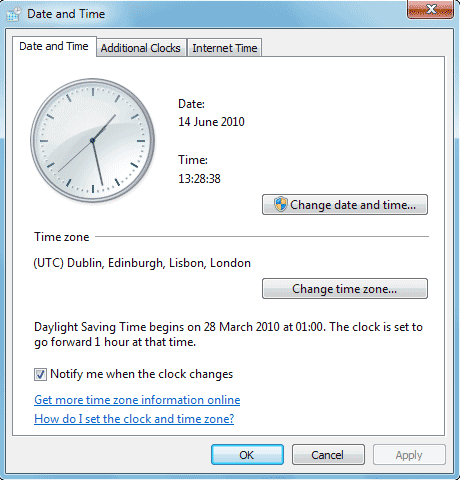
Solution 2: temporarily disable antivirus and firewall programs
Software (to protect against malware) and a firewall are mandatory for every user who plans to connect their device to the Internet. However, since security tools like these work with various algorithms and rules, they can prevent access to certain websites even if they don’t pose a security risk. For example, it is possible that the IP address or domain address has been classified as a security risk and that’s why it’s being blocked. Chrome also displays the ERR_SSL_PROTOCOL_ERROR message if SSL connections are generally blocked by a tool.
You can easily test whether the security programs you are using are triggering the error message by temporarily disabling them and revisiting the website in question. If the connection setup now works without problems, you know that you have to make changes in the settings of the programs and remove the IP address from the blacklist.
To display this video, third-party cookies are required. You can access and change your cookie settings here.
Solution 3: delete SSL cache and browser cache
In some cases, cached information in the SSL cache (SSL status) or browser cache may also be responsible for the ERR_SSL_PROTOCOL_ERROR message in Chrome. If this is the case, all you have to do is clear the cache to rectify the error.
In Chrome, simply open the settings menu by clicking on the three dots in the top right-hand corner and choose the ‘Settings‘ option from the drop-down menu.
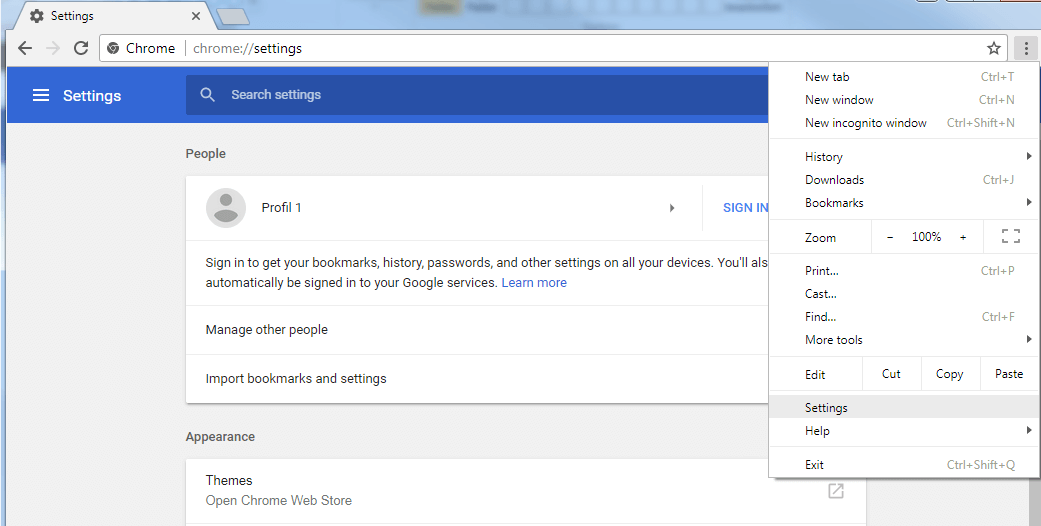
Click the ‘Advanced‘ button to access the ‘Privacy and security‘ options. There you will find what you’re looking for – ‘Clear browsing data‘, which you can use to delete the Chrome cache.
Tip
You can also access the cache delete menu in an even quicker way by entering the following address as the URL: chrome://settings/clearBrowserData.
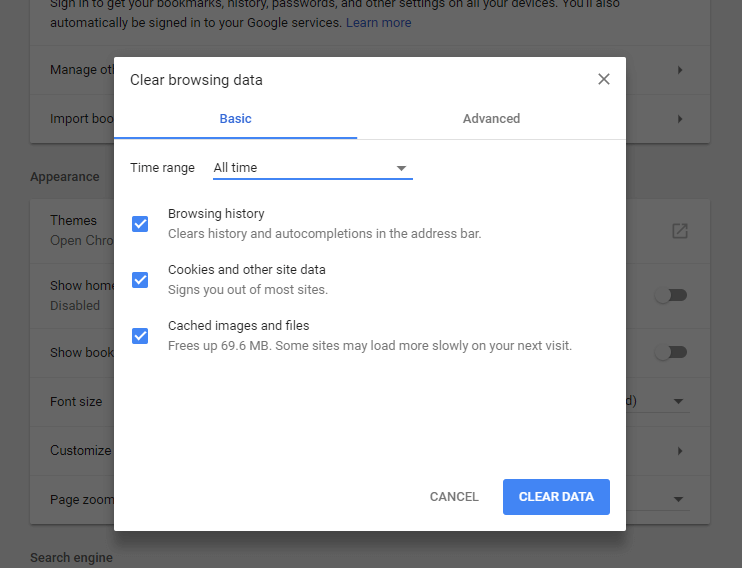
The SSL cache is managed by the operating system itself, which is why it cannot be deleted using Chrome. You will find the corresponding function in the network and internet setting, which can be accessed in Windows via the control panel.
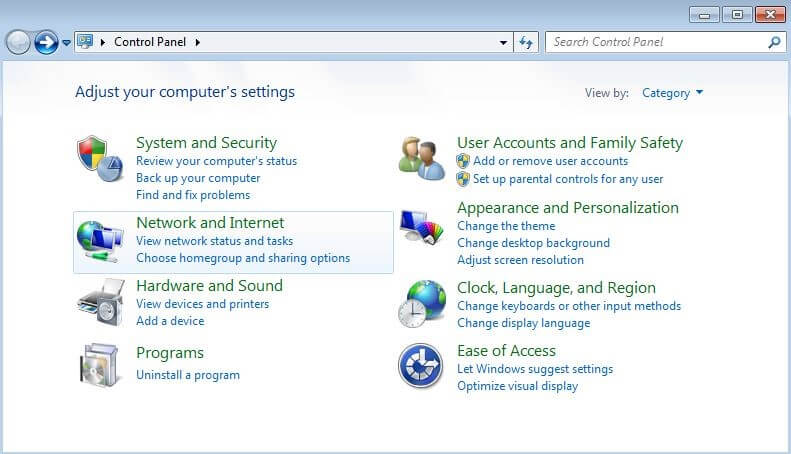
In ‘Network and Internet’, you will find ‘Internet Properties’, which you should select. Then click the ‘Content’ tab, then click ‘Clear SSL state’.
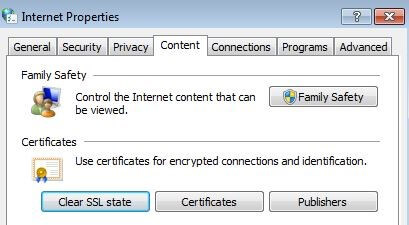
You receive a status report when the cache has been deleted and you can then check whether the ERR_SSL_PROTOCOL_ERROR problem has been solved by emptying the cache then accessing the site again using Chrome.
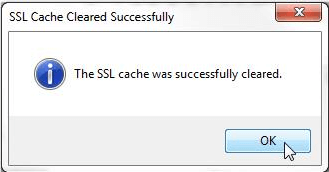
Solution 4: deactivate Chrome extensions
Just like every internet browser, Google Chrome can be extended with plugins, which add additional features, games, or new designs to the user interface. However, with each additional extension, you run the risk of impairing the browser’s functionality and causing error messages such as ERR_SSL_PROTOCOL_ERROR. If the previous solutions haven’t been successful, it might be worthwhile to deactivate the extensions until you want to use them again. If the SSL connection is then able to be successfully established, you know it was the extension that was blocking it. By reactivating the extensions step by step (including doing the connection test), you can easily identify what was responsible.
To access the extensions, click on the three dots next to the browser’s search bar, just like when you’re deleting the Chrome cache. From the drop-down menu, select ‘More tools‘, then ‘Extensions‘.
Tip
You can also enter chrome://extensions/ into the search bar to go directly to the extensions.
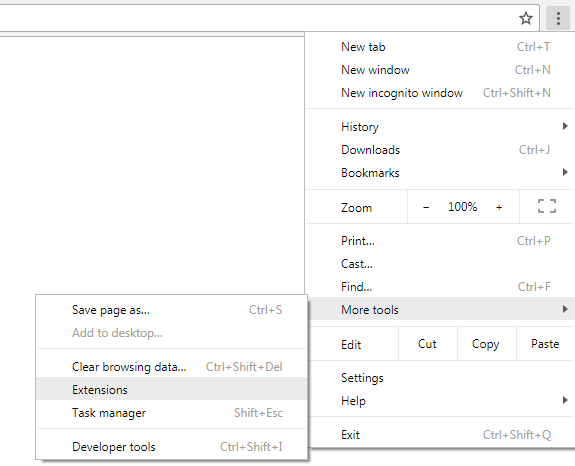
Deactivate the activated extensions one after the other by unchecking all the checked boxes, then restart Chrome and check if ERR_SSL_PROTOCOL_ERROR continues to occur when you try to access the target website.
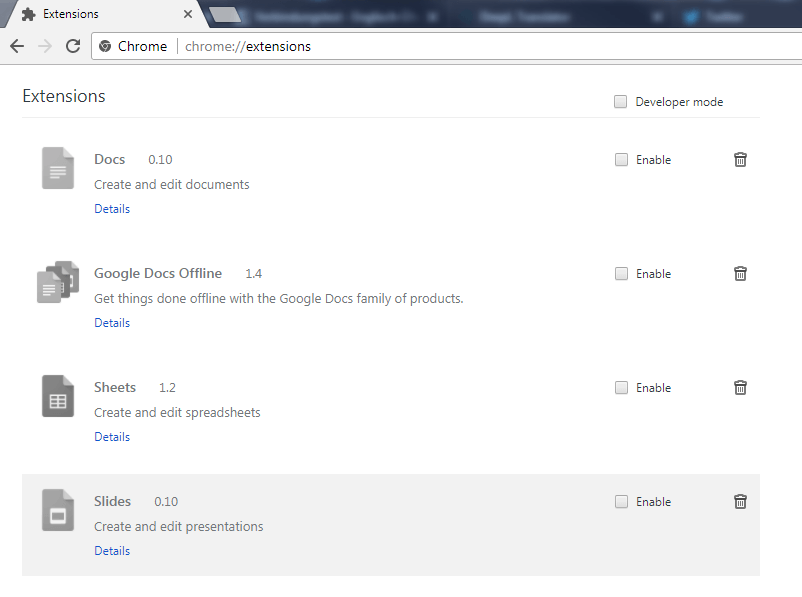
Solution 5: switch off the QUIC protocol
Google Chrome was one of the first browsers to implement QUIC. The future-oriented protocol is intended to provide extra speed when setting up a connection, among other things. Officially still in the test phase, it is already activated by default as an ‘experimental protocol‘ in various services offered by the large corporation such as the Google browser, which means it could be a possible cause for the ERR_SSL_PROTOCOL_ERROR. It is sometimes enough to simply deactivate QUIC to solve the problem. To do this, first enter the following address in the search bar:
chrome://flags/#enable-quic
In the Chrome flag menu, all features are listed that have not yet been officially implemented in the browser. Here you will see ‘Default’ chosen, which means that QUIC is active. To switch the protocol off, select the ‘Disabled‘ option and restart Chrome.
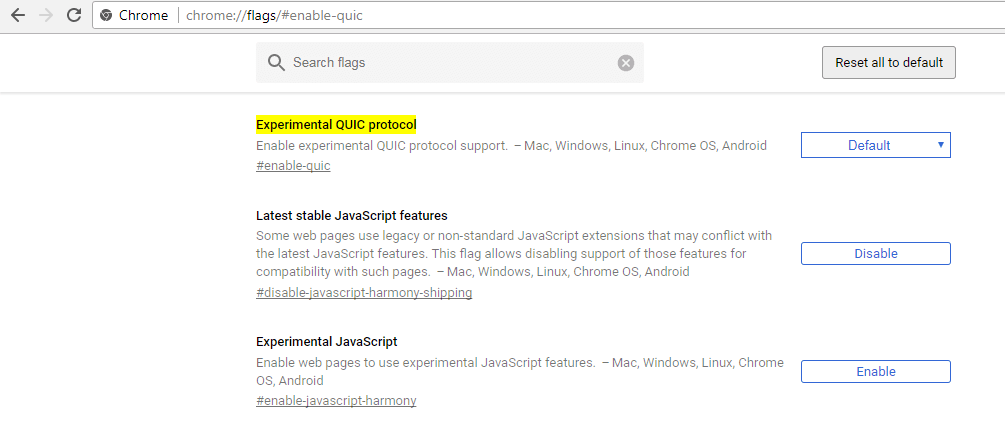
Solution 6: delete or reset hosts file to its default setting
Before the Domain Name System (for name resolution on the internet) was introduced and established, a system based on local text files was used, which had to be maintained manually. This file named ‘hosts’ still exists today in common operating systems, but is usually only used for assigning addresses in local networks.
It is, however, possible for malicious programs to modify the hosts file so that you are redirected to the wrong websites or so that error messages such as ERR_SSL_PROTOCOL_ERROR appear. However, by deleting the file or restoring the default settings (if you have made your own network configurations), you can quickly fix this problem. With Windows, it works like this:
- Open the ‘Run’ program by pressing the Windows key and [R] at the same time.
- In the new window, specify the directory in which the hosts file is located by inserting the following line (if Windows is not installed on C:, you must use the appropriate drive letter):
C:WindowsSystem32driversetc
- Once you’ve confirmed the entry by clicking on ‘OK’, you will get to the destination folder where you can select and delete or edit the hosts file.
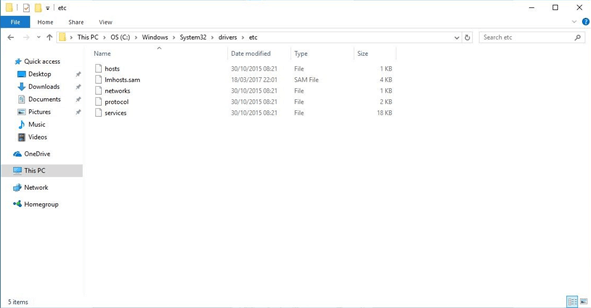
Users of other systems can proceed in the same way (access directory, then delete the file), but the directory path varies from system to system: macOS, Unix, Linux, and Android users can find the hosts file in /etc/hosts. iOS stores the file in the /private/etc/hosts directory.
Related articles
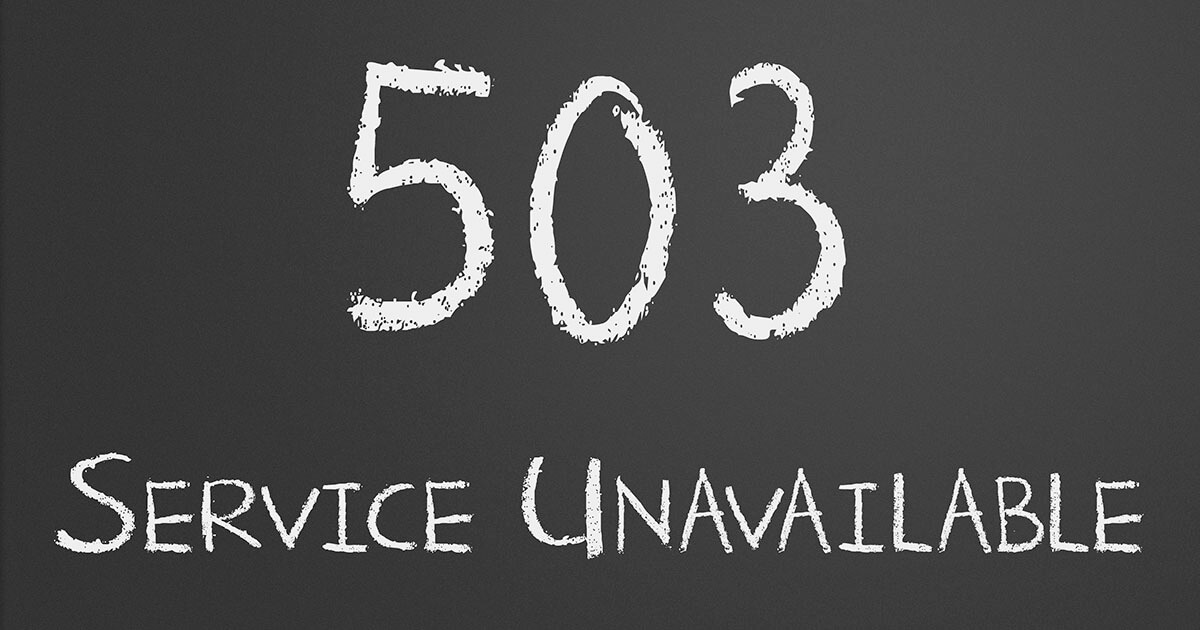
HTTP 503 (Service Unavailable): meaning and troubleshooting
It’s very likely that you’ve stumbled on the ‘HTTP Error 503 The service is unavailable’ notification or something similar during your daily browsing. The error message appears whenever a web server can’t display the website that the user is trying to access. There are many reasons for these notifications, just as there are many solutions. It’s your responsibility as the website operator to…
HTTP 503 (Service Unavailable): meaning and troubleshooting

How to fix HTTP 500 internal server error?
Error messages when surfing the net are a nuisance for everyone involved, but especially for those who have to find out what the problem is. The search for a solution can be particularly tedious if the status code message barely provides any information on the source of the error. The HTTP error 500 (“Internal Server Error”) is a collective status code. We give you tips on where errors could have…
How to fix HTTP 500 internal server error?

ERR_CONNECTION_CLOSED: How to fix the connection error
If Chrome displays the message «ERR_CONNECTION_CLOSED» instead of the website you want to access, it means that the contacted server has interrupted the connection. Reloading the URL is often not enough to fix the problem. Unfortunately, determining the source of the error is anything but a simple task. To fix the «ERR_CONNECTION_CLOSED» error, you need a good amount of patience.
ERR_CONNECTION_CLOSED: How to fix the connection error
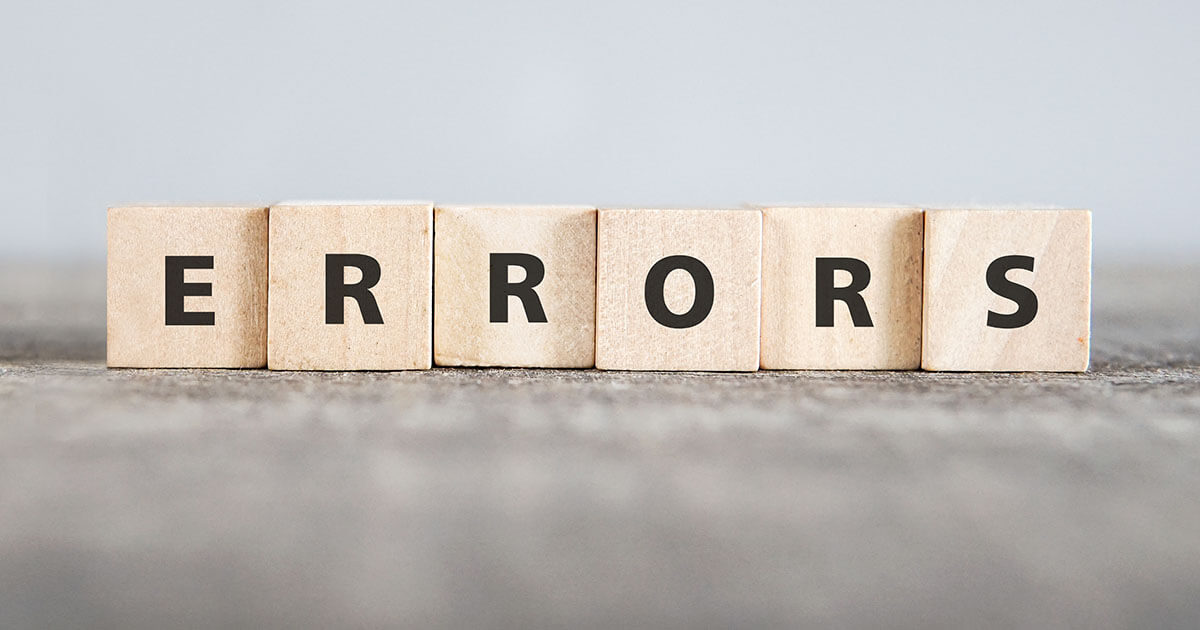
INET_E_RESOURCE_NOT_FOUND: How to fix the Microsoft Edge error
Via the Windows Update feature, Microsoft provides users with the latest features and fixes for Windows or installs Microsoft services and apps. Since the Creators Update V1703, some users have been receiving the message “INET_E_RESOURCE_NOT_FOUND” when they try to access the Microsoft Edge browser. But what exactly does this error mean and how can it be rectified?
INET_E_RESOURCE_NOT_FOUND: How to fix the Microsoft Edge error

Windows 7, 8, 10 will no longer start – causes and solutions
Every Windows user knows: No matter which version you use, the popular Microsoft operating system has its bad days. Sometimes these are so serious that the worst possible outcome happens: Windows won’t boot anymore. You might think there’s nothing you can do, but don’t panic: Boot problems and bluescreens can be solved quickly in most cases.
Windows 7, 8, 10 will no longer start – causes and solutions

